

Tourism Industry SWOT Analysis 2024 With Key Insights
The tourism industry is one of the largest industries in terms of market size, not to mention a channel to connect different people, history, and culture. People have been traveling since Adam, and we couldn’t even explore half of the world, which we will get to know more about in this tourism industry SWOT analysis.
Table of Contents
Tourism Industry Overview
The Egyptians, Greeks, and Romans engaged in early forms of tourism, traveling for religious pilgrimages, leisure, and educational purposes. The ritual continues with more options, better transportation, accommodation, and different forms.
Over a thousand years of history, the industry has become a $2T industry, with thousands of spots and employing 295M people worldwide.
Competitors in Tourism Industry booking.com | Airbnb | Expedia | Hilton | Marriott | Royal Caribbean Internation | Norwegian Cruise
Did You Know? In 1967, a travel agency in Illinois offered reservations for trips to the moon, even though the technology and logistics were far from feasible at that time.
Strengths – Tourism Industry SWOT Analysis
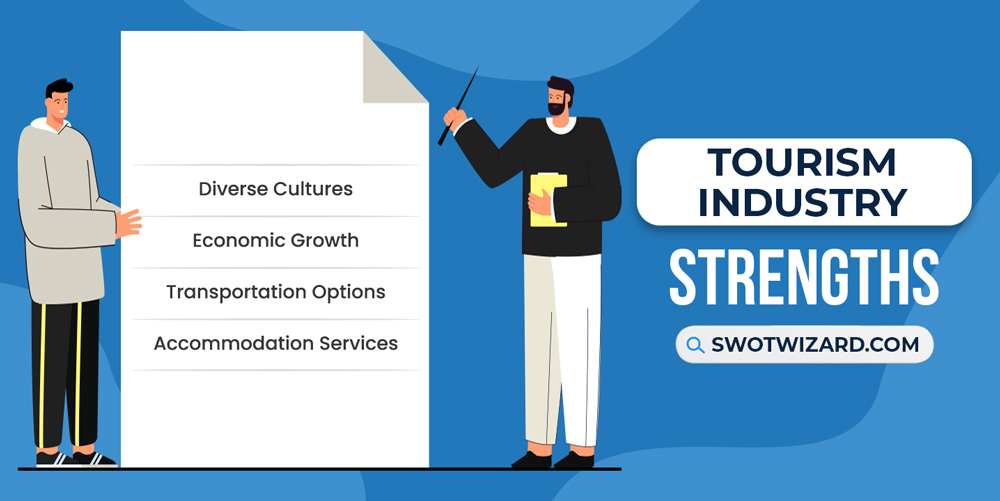
Diverse Cultures: Tourism allows travelers to experience and learn about new cultures, and Experiencing local art, food, and traditions is a major draw. According to the data, cultural tourism accounted for nearly 40% of all global tourism, generating billions in tourism receipts globally, according to UNWTO.
Economic Growth: Tourism stimulates infrastructure investment and creates transportation, hospitality, and retail jobs. As a result, the tourism industry alone contributed 7.6% of global GDP and created 295M jobs globally in 2022, according to WTTC. In Hawaii, the industry contributes almost the GDP, and many countries like this depend entirely on the single sector and employ most of the people.
Transportation Options: Modern transportation networks provide easy access to global destinations, and because of that, Global air connectivity has increased by over 67% in the last decade, enabling convenient tourism growth. Options like budget airlines and cruises allow travelers access at competitive rates, and the efficiency of Tokyo’s extensive public transportation system is the perfect example.
Accommodation Services: The hospitality industry’s evolution accommodates diverse traveler preferences like homestays, hostels, resorts, etc. There were approximately 18M hotel rooms globally, with annual occupancy rates exceeding 70.1% in many regions. Besides, Airbnb offers unique stays, boosting local economies while providing personalized experiences that resonate with today’s travelers.
Weaknesses – Tourism Industry SWOT Analysis
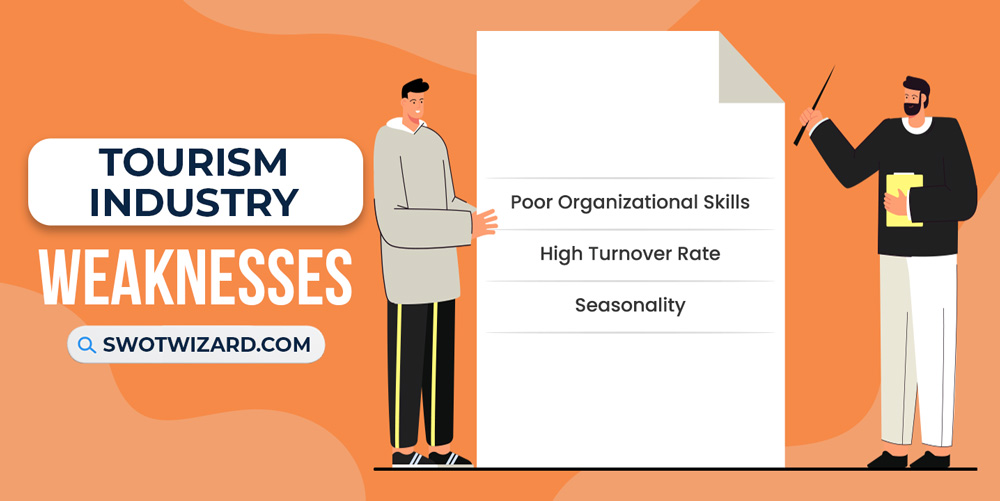
Poor Organizational Skills: Inefficiencies in coordination can hinder the seamless operation of tourist facilities, and as an industry, the businesses often lack strategic planning and vision. According to the data, less than 14% of tour companies in Africa had business plans, leading to haphazard decision-making.
High Turnover Rate: The industry often grapples with high employee turnover due to demanding work conditions and the seasonal nature of the business. The turnover rates reached 34.6% for leisure and hospitality employees in the USA alone in 2022, impacting service consistency.
Seasonality: Tourism demand fluctuates significantly between peak and off-peak seasons, requiring flexibility in staffing and operations. If we look at the data, the hotel occupancy rates in Miami ranged from 83% in March to 62.8% in September, a 25% swing between high and low season in the last year.
Opportunities – Tourism Industry SWOT Analysis
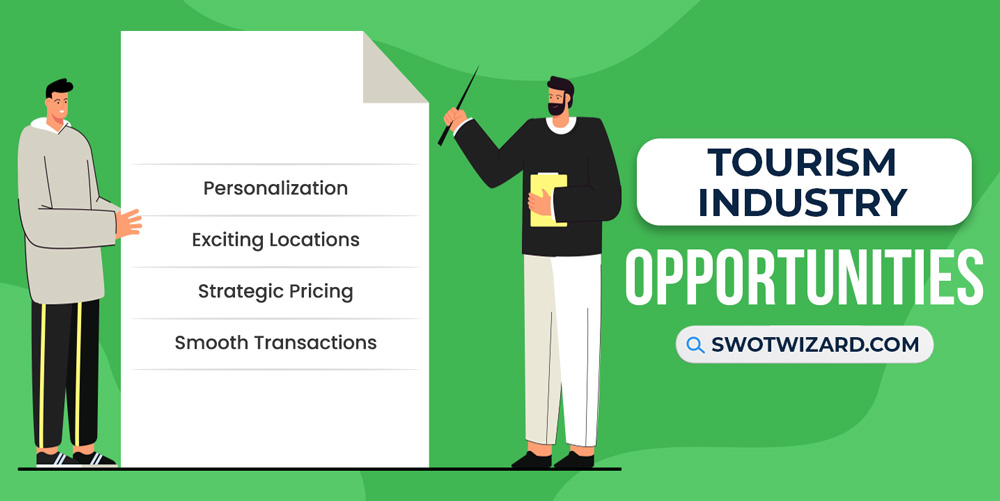
Personalization: Tailoring experiences to individual preferences fosters a deeper connection, and travelers increasingly want customized, authentic experiences. The global personalized travel market is projected to grow at a CAGR of around 4.42% from 2023-2027. Besides, Airbnb’s personalized recommendations based on traveler history have led to a massive increase in guest bookings.
Exciting Locations: Seeking new destinations, like up-and-coming cities or exotic natural sites, drives tourism. Adventure travel spending reached $1036B in 2022, growing by 19.6% in the past six years, and the success of Iceland’s tourism showcases how breathtaking landscapes can draw visitors seeking unforgettable adventures.
Strategic Pricing: Dynamic pricing driven by demand data allows tourism businesses to maximize revenues. Airlines change fares 500M times daily based on date, destination, and competition, leading to a 5-10% increase in revenue across the industry. Similarly, Disney’s tiered ticket pricing increased revenue by 25% at peak times while promoting off-peak visits.
Smooth Transactions: Tourism tech startups are easing travel planning, like online booking sites aggregating flight/hotel deals. Global travel sales through mobile are projected to account for $1T, over 90% of online bookings in 2030, up from 50% in 2022, $798B, demonstrating the impact of user-friendly transactions.
Threats – Tourism Industry SWOT Analysis
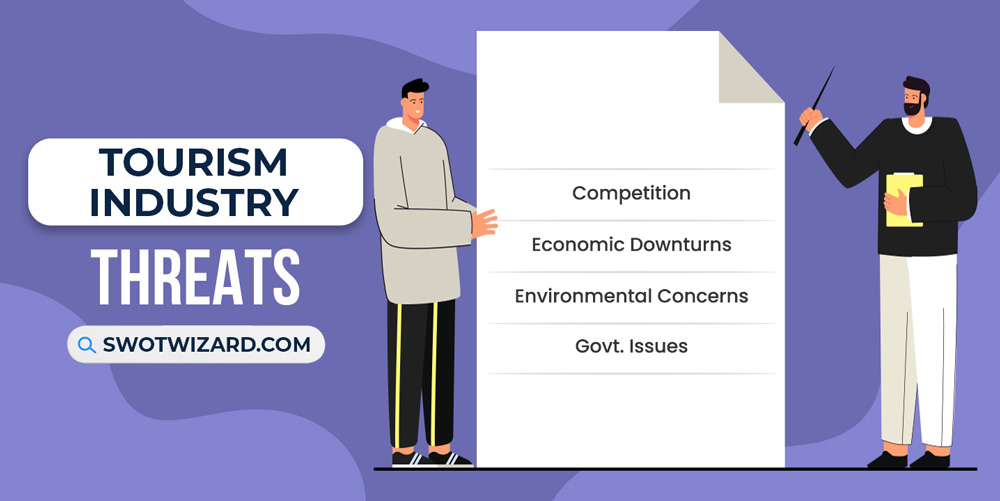
Competition: Intense rivalry among destinations amplifies the pressure to differentiate. European cities like Paris and Rome compete for cultural tourism, investing in museums and historical sites to entice travelers, intensifying the struggle for the tourism market share. If we look at the data, Southeast Asia saw tourism grow significantly in the last few years, while arrivals fell in Europe during the same period.
Economic Downturns: Economic instability curtails disposable income, impacting travel decisions. The 2008 financial crisis saw a global decline in tourism growth, with international tourist arrivals dropping by 4.2%, highlighting the industry’s vulnerability to economic downturns. As a result, it’s concerning as there is a 2024 recession coming the way, and it might hit the industry significantly.
Environmental Concerns: Heightened awareness of sustainability sparks traveler scrutiny, and Tourism contributes to 5% of global CO2 emissions from transport, infrastructure, and activities, and it might increase to 5.3% in the next few years. The Great Barrier Reef’s coral bleaching drew attention to ecotourism’s dilemma, as visitors became more conscious of their environmental impact, reducing tourist interest and revenues.
Govt. Issues: Evolving regulations can disrupt travel plans, and changes to visa policies, travel advisories, regulations, etc., have become a huge issue nowadays. Brexit created uncertainty for travelers between the UK and the EU, with changing visa requirements and border processes altering travel dynamics and potentially discouraging visits. Not to mention, after the USA imposed travel restrictions a few years ago, its share of the long-haul travel market fell.
[Bonus Infographic] SWOT Analysis of Tourism Industry
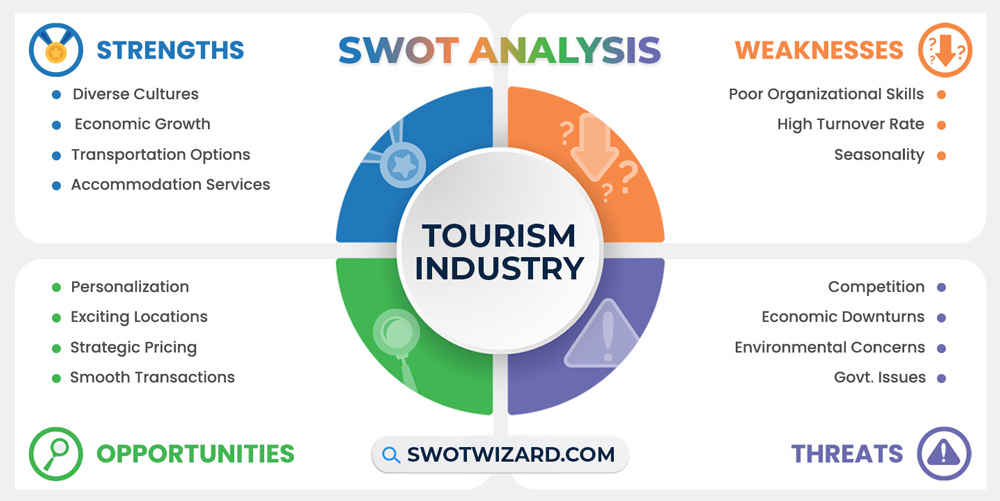
Recommendations for Tourism Industry
Keeping up with the change and growing overall is crucial in the ever-changing tourism industry. Here are some recommendations for the stakeholders in the industry.
- Tailor marketing efforts to individual preferences and behaviors, like targeting families with deals on kid-friendly activities and restaurants.
- Highlight destinations’ unique experiences through immersive storytelling and promote off-the-beaten-path destinations to establish location brands with new exciting locations.
- Implement dynamic pricing models to accommodate diverse customer segments and demand fluctuations.
- Invest in seamless online booking and payment systems, self-service kiosks, and mobile apps to facilitate frictionless trip planning and on-site transactions.
- Partner with providers of unique accommodations like homestays, cabins, and boutique hotels to offer personalized and authentic stays.
Frequently Asked Questions (FAQs)
What are the three principles of tourism.
The three principles of tourism are environmental, social, and economic sustainability.
What are the 4 A’s of tourism?
The 4 A's of tourism are attraction, accessibility, amenity, and ancillary services.
How big is the tourism industry?
The tourism industry is $2T big.
Final Words on Tourism Industry SWOT Analysis
The tourism industry is dynamic in an ever-evolving landscape, offering boundless opportunities and navigating intricate challenges. Balancing innovation with sustainability and personalized experiences with mass appeal remains a cornerstone of global economies. With strategic adaptation and collaborative efforts, the industry can continue to unlock the world’s wonders while fostering economic growth and cultural exchange.
- Kelleher, S. R. (2023, August 9). Go Time: Airfares Are Dipping, But Low Prices Won’t Last Long . Forbes.
- Walker, T. (2023, July 5). Vietnam emerging as Southeast Asia’s new tourist hot spot . dw.com.
About The Author
Sejan Mahmud
Explore more swot analysis.

Pharmaceutical Industry SWOT Analysis 2024 With Key Insights
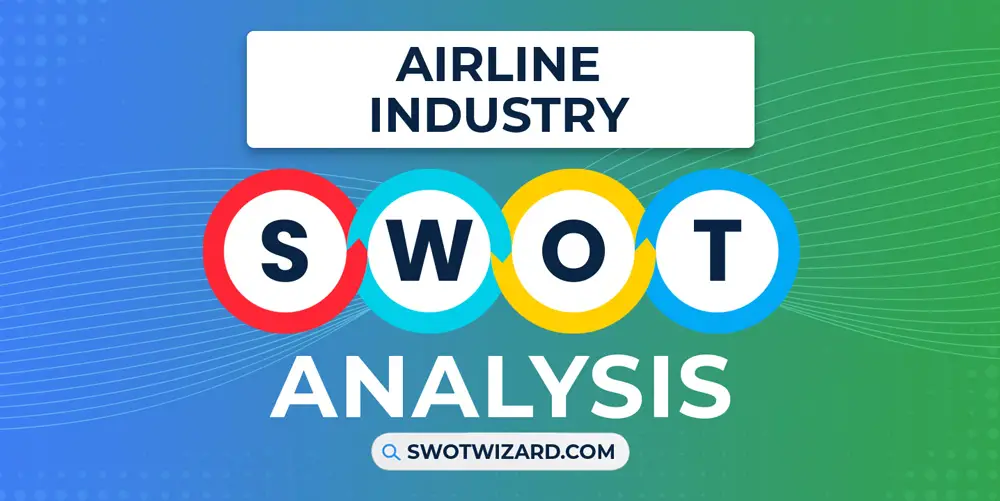
Airline Industry SWOT Analysis 2024 With Key Insights

Hotel Industry SWOT Analysis 2024 With Key Insights
Leave a comment cancel reply.
Your email address will not be published. Required fields are marked *
Save my name, email, and website in this browser for the next time I comment.

FREE Q4 2023 CONTENT MARKETING PLANNER

In the world of tourism, crafting a strategic marketing plan is crucial for the success of your venture. One indispensable tool for such planning is the SWOT analysis.
What is a SWOT Analysis?
A SWOT analysis is a strategic planning tool that helps tourism businesses identify and evaluate their internal strengths and weaknesses, as well as external opportunities and threats. It provides a structured framework for assessing various aspects of a business and its environment, which can inform strategic decision-making.
Understanding the Structure of a SWOT Analysis
Before we delve into the details, it’s essential to grasp the framework of a SWOT analysis, which is divided into four distinct areas:
Internal Factors
Strengths (S): These are internal attributes and characteristics of your business that give you an advantage over others. Strengths are factors that you control and can leverage for your business’s benefit. Weaknesses (W): These, too, are internal aspects, but they represent limitations or shortcomings within your organisation. Weaknesses are factors within your control, and you can work to address them to improve your business’s performance.
External Factors

Why is a SWOT Analysis Important for a Tourism Business?
A SWOT analysis is particularly crucial for tourism businesses due to the industry’s dynamic nature.
- Strategic Planning: Tourism businesses need to adapt to ever-changing market conditions. A SWOT analysis offers a structured approach to identifying areas that need attention and resources.
- Competitive Advantage: Tourism businesses can leverage their unique attributes to gain a competitive edge by understanding their strengths and weaknesses. This can be critical in a crowded marketplace.
- Risk Mitigation: Recognising potential threats in advance allows tourism businesses to proactively address them, reducing the likelihood of being caught off guard by external factors.
- Opportunity Maximisation: Identifying opportunities ensures that tourism businesses can exploit emerging trends and market shifts, potentially increasing revenue and market share.
Identify Internal Influences – Strengths and Weaknesses
Strengths (s):.
Strengths are internal attributes that are intrinsic to your business, and you have control over them. They represent the positive aspects of your organisation that provide you with an advantage. When considering strengths for your tourism business, think about attributes such as:
- Unique Selling Points: What sets your tourism business apart? It could be your location, the experiences you offer, or your exceptional customer service.
- Quality of Service: Assess the level of service you provide. Do you have a strong reputation for delivering exceptional experiences to your guests?
- Loyal Customer Base: Consider the number of repeat customers. A strong base of loyal guests is a significant strength.
- Resource Availability: What resources do you have, both tangible and intangible, that contribute to your success?
- Expertise and Skills: Evaluate the skills and expertise of your team, which can be a vital strength.
Weaknesses (W):
Weaknesses are internal aspects that can hinder your business’s success. These factors represent limitations or areas that need improvement within your organisation. As you identify weaknesses in your tourism business, think about elements such as:
- Budget Constraints: If your tourism business operates with a limited marketing or operational budget, it can affect your reach and competitiveness.
- Seasonal Demand: Assess whether your business faces significant fluctuations in demand due to seasonality.
- Infrastructure Limitations: Consider any limitations or maintenance issues related to your physical facilities.
- Staffing Challenges: Are there any issues related to staffing, such as understaffing during peak seasons?
- Outdated Technology: Outdated technology, including your website or reservation systems, can be a weakness in today’s digital age.
Identify External Influences – Opportunities and Threats
Opportunities (o):.
Opportunities are external factors beyond your tourism business control but can be favourable for your business. These factors exist outside your business and can create opportunities for growth and success. When identifying opportunities, consider aspects such as:
- Market Trends: Identify emerging trends in the tourism industry, such as eco-tourism or experiential travel.
- Collaboration: Look for opportunities to collaborate with local businesses, attractions, regional, state and national tourism industry bodies or online travel agencies (OTAs).
- Digital Marketing: Explore the potential of leveraging digital marketing and online booking platforms.
- Government Incentives : Investigate any government grants or incentives related to tourism.
- Diversification: Can you diversify your product or services, such as adding adventure packages or event hosting, to tap into new customer segments?
- Local Events and Festivals: Capitalise on local events and festivals to boost bookings during peak seasons.
Threats (T):
Threats are external factors that can pose potential risks or challenges to your business. These factors, like opportunities, are beyond your immediate control but can impact your business negatively. When identifying threats to your tourism business, think about elements such as:
- Competition: Recognise the competitive landscape in your area or niche. New businesses and established competitors can affect your market share.
- Economic Downturns: Economic fluctuations can impact discretionary spending on travel and tourism, affecting your business.
- Weather-Dependent Tourism: Poor weather can be a significant threat if your business relies on favourable weather conditions.
- Regulatory Changes : Be aware of potential changes in local or national regulations that might affect your business, such as zoning laws or safety standards.
- Online Reputation: Negative online reviews, social media backlash, or customer complaints can harm your business’s reputation and deter potential guests.
- Natural Disasters: Unpredictable natural disasters, such as storms, earthquakes, or wildfires, can disrupt travel plans and affect tourism in your area.
- Environmental Factors : Increasing awareness of environmental sustainability and concerns about the ecological impact of tourism.
- Global Pandemics: The outbreak of global pandemics, like the COVID-19 pandemic, can lead to travel restrictions, reduced tourism demand, and concerns about health and safety.
An Example of Tourism SWOT Analysis
Now that you understand a SWOT Analysis, here is an example based on an accommodation provider – a historic bed and breakfast accommodation in the Yorke Peninsula.
Internal Factors – Strengths and Weaknesses
- Prime Location: The bed and breakfast is on the Yorke Peninsula, known for its natural beauty and outdoor activities.
- Charming Aesthetic : The property features a charming, vintage aesthetic that appeals to guests seeking a unique experience.
- Excellent Customer Service : The bed and breakfast has a track record of providing exceptional customer service and personalised experiences.
- Loyal Customer Base: The business has a loyal customer base that often returns for repeat visits.
- Well-Maintained Facilities: The property is well-maintained and offers modern amenities in a rustic setting.
- Unique Ambiance: The bed and breakfast offers a unique, cozy ambience that sets it apart from chain hotels.
- Excellent Guest Reviews: Past guests consistently leave positive reviews praising the accommodation, hospitality, and overall experience.
- Dedicated Staff: The small family team is committed to delivering personalised service and ensuring guest satisfaction.
- Well-Defined Brand Identity: The bed and breakfast has a well-defined brand identity that resonates with its target audience.
Weaknesses:
- Limited Marketing Budget: The business struggles with marketing due to a limited budget, which affects its visibility and reach.
- Seasonal Demand: The Yorke Peninsula experiences significant seasonal fluctuations in tourism, which involves the business’s year-round revenue.
- Limited Capacity: The bed and breakfast has a limited number of rooms, which can lead to turning away potential customers during peak seasons.
- Staffing Challenges: The small staff needs help managing peak occupancy, leading to occasional service delays.
- Aging Infrastructure: The property’s infrastructure, while charming, requires ongoing maintenance and can be costly to update.
- Limited Marketing Budget: The business struggles with marketing due to a limited budget, affecting its visibility and reach.
- Limited Marketing Expertise: The team lacks in-depth marketing expertise, hindering the development of effective marketing strategies.
- Seasonal Demand: The business experiences significant seasonal booking fluctuations, challenging consistent marketing.
- Outdated Website: The website, a critical marketing tool, is outdated and not optimised for mobile devices.
- Inconsistent Social Media Presence: The establishment’s social media accounts are sporadically updated, leading to missed engagement opportunities.
External Factors – Opportunities and Threats
Opportunities:.
- Eco-Tourism Trend: Increasing interest in eco-tourism aligns with the natural beauty of the Yorke Peninsula, presenting an opportunity for niche marketing.
- Collaborations with Local Businesses: Partnering with local tour operators, restaurants, and complementary businesses can enhance the guest experience and create mutually beneficial relationships.
- Online Booking Platforms: Leveraging online booking platforms can expand the bed and breakfast’s reach to a broader audience.
- Government Grants and Incentives: Government incentives for historic, unique or eco-friendly accommodations can provide financial support for property upgrades.
- Diversification: Expanding the business to include experience packages such as private tastings, property tours, or spa services can attract a broader clientele.
- Competition: An increasing number of accommodation options on the Yorke Peninsula means fiercer competition.
- Economic Downturn: Economic downturns can impact discretionary spending on travel and tourism.
- Weather-Dependent Tourism: Poor weather conditions can deter tourists from visiting the region, affecting revenue.
- Regulatory Changes: Changes in government regulations, such as zoning laws or safety standards, could require costly modifications to the property.
- Online Reputation: Negative online reviews or social media backlash can harm the business’s reputation and deter potential guests.
- Economic Downturn: Economic downturns can affect discretionary spending on travel and tourism.
- Online Reputation Management: Negative online reviews or social media backlash can harm the establishment’s reputation and deter potential guests.
- Natural Disasters: Unpredictable natural disasters, such as bushfires, floods, or extreme weather events, can disrupt travel plans and impact tourism in the area. Preparing contingency plans for such events is essential to ensure guest safety and business continuity.
- Environmental Factors: Growing concerns about ecological sustainability may lead to changing preferences and demand for eco-friendly accommodations. To address this, consider implementing eco-friendly practices and promoting your establishment as an environmentally responsible choice.
- Global Pandemic: The outbreak of global pandemics, like the COVID-19 pandemic, can lead to travel restrictions, reduced tourism demand, and concerns about health and safety. Developing and implementing health and safety protocols, as well as flexible booking policies, is crucial to address the challenges posed by global pandemics and ensure the safety and confidence of guests.
Next steps…
Marketing Strategy Based on the Example SWOT Analysis
Now that we have a comprehensive SWOT analysis for the small bed and breakfast on the Yorke Peninsula, it’s time to craft strategies based on the insights gained:
Based on the SWOT analysis, we can formulate strategies to strengthen the marketing plan of the small bed and breakfast: The strategies developed through the SWOT analysis provide a roadmap for the small bed and breakfast to leverage its strengths, mitigate weaknesses, seize opportunities, and defend against threats. It’s essential to continually assess and adjust these strategies as the marketing landscape evolves.
Strengths-Driven Marketing Strategies:
- Leverage Unique Ambiance: Emphasise the cozy and vintage ambience of the property in marketing materials. Highlight how it offers a distinctive experience compared to chain hotels, appealing to guests seeking something unique and charming.
- Customer Testimonials: Utilise excellent guest reviews by showcasing them prominently on the website and in marketing materials.
- Refine Brand Identity: Build on your well-defined brand identity to ensure it resonates with the target audience. Consider refreshing your branding to reflect the vintage aesthetic and unique ambience.
- Repeat Guest Incentives: Implement a loyalty program that offers discounts, special packages, or exclusive access to returning guests.
- Partnerships with Local Businesses: Collaborate with tour operators, restaurants, and complementary businesses to create exclusive guest packages. Cross-promotion can attract more visitors and enhance the overall experience.
Weaknesses-Addressing Marketing Strategies:
- Marketing on a Limited Budget: Focus on cost-effective marketing strategies, such as social media marketing, content marketing, and email marketing. You can also explore low-cost or free local advertising options and leverage your loyal customer base to spread the word.
- Staffing Challenges: Consider hiring temporary cleaning staff during peak seasons to help manage the increased turnover demand. Provide additional training to ensure the service quality remains high even during busy periods.
- Infrastructure Maintenance: Prioritise necessary maintenance and updates for aging infrastructure. Highlight any renovations or improvements in marketing materials to show that the guest experience is continuously enhanced.
- Website and Social Media: Invest in updating the website to make it mobile-friendly, easy to navigate and search optimised. Establish a consistent social media posting schedule to engage with potential guests regularly and promote unique offerings.
Opportunities-Exploiting Marketing Strategies:
- Eco-Tourism Marketing: Highlight the eco-friendly aspects of the location and property. Embrace sustainable practices and promote as an environmentally responsible choice to attract eco-tourists. Do not greenwash , though.
- Online Booking Platforms: Regularly update and optimise presence on online booking platforms, ensuring that listing is appealing, well-maintained, and contains high-quality images and accurate information.
- Government Grants and Incentives: Research and apply for government incentives that support historic or eco-friendly accommodations. This can provide financial support for property upgrades and sustainability initiatives.
- Diversification: Expand offerings to include experience packages, such as private tastings, property tours, or spa services, to attract a broader clientele and differentiate your B&B from competitors.
FURTHR READING: Tourism Greenwashing: How to Avoid it and Control Your Marketing Message
Threats-Mitigation Marketing Strategies:
- Competition: Monitor competitors and adjust marketing strategies accordingly. Differentiate offerings and continuously seek ways to stay ahead in the competitive landscape.
- Economic Downturn: Diversify marketing efforts to target budget-conscious travellers, offering special deals and packages during economic downturns to maintain bookings.
- Regulatory Changes: Stay informed about regulatory changes and proactively adapt the property to meet new standards, ensuring compliance while avoiding costly last-minute modifications.
- Online Reputation Management: Actively manage online reputation by responding to positive and negative reviews promptly and professionally. Showcase commitment to guest satisfaction.
- Natural Disasters: Develop and communicate contingency plans to address the impact of natural disasters on travel plans. Ensure the safety and comfort of guests during such events.
- Global Pandemic Preparedness: Develop health and safety protocols and flexible booking policies to address the challenges posed by global pandemics.The strategies developed through the SWOT analysis provide a roadmap for the bed and breakfast to capitalise on its strengths, mitigate weaknesses, seize opportunities, and defend against threats. It’s essential to continually assess and adjust these strategies as the business environment evolves.
Wrapping it Up
A SWOT analysis is not a one-time exercise. It should be revisited regularly to adapt to changing circumstances and ensure your marketing efforts remain competitive and aligned with your business goals. Whether you’re just starting your marketing plan or looking to revamp an existing one, the SWOT analysis is a foundational step in the strategic planning process that can make a significant difference in your tourism business success.

Tania Shirgwin
Founder + Head Consultant
Tania is a marketing strategist specialising in tourism, wine and hospitality marketing. As founder of Decant Digital (formerly bizeez communications), Tania’s unique role over the past 14 years has enabled her to follow her passions of travel and her marketing obsessions of strategic marketing planning, consumer-focused web development, search optimisation, and training. With over 80 customised websites built to date, successful event marketing campaigns and new business branding, Tania’s wealth of experience ensures businesses continually increase website traffic, direct bookings, and sales via proven marketing tactics.
You May Also Like

How ChatGPT can revolutionise your tourism marketing
Artificial intelligence (AI) has become a game-changer for various industries in today's digital age. One remarkable AI tool that has gained significant attention is ChatGPT. This powerful online tool developed by OpenAI has the potential to revolutionise the way...

Tourism Greenwashing: How to Avoid it and Control Your Marketing Message
There has been a growing trend of consumers wanting to live more sustainably and make environmentally friendly choices in recent years. As a result, many tourism businesses have started to promote their products and services as 'sustainable', 'green' or 'eco-friendly'...

Public Relations for Tourism: Crafting Your Unique Strategy
Establishing a good reputation is crucial to running a tourism business, as is generating ongoing positive publicity to maintain your brand’s reputation. Think of it this way, as more people become aware of your tourism business, the potential of turning them into...

Improve Your Tourism Website Search Rankings with these handy Meta Description Tips
The key to attracting more visitors to your tourism website is to make it easily findable on Google and other search engines. Think of it this way, your website has two main, but different goals:1) Rank well on search engines2) Engage and convert your target audience...

How to Write a Successful Tourism Marketing Plan in 10 Steps
Planning for Success A successful tourism marketing plan is an essential and powerful business tool. Not only does it focus on the why, how, when, where, who and what of your marketing, but also outlines the specific, measurable steps you need to take to achieve your...

24 Time Saving Tourism Marketing Tactics to Implement in 2024
The life of a tourism business owner can be stressful. You undoubtedly wear many hats, including customer service representative, guide, bookkeeper, cleaner, team leader and marketing manager. And the list of roles may go on and on... All the while facing a barrage of...
LET’S CONNECT
Marketing Inspiration for Wine, Tourism + Hospitality
Join a growing number of savvy Wine, Tourism, Hospitality professionals who receive tips direct to their inbox.
Welcome to the Decant Digital marketing family.
Select the option that closely matches your role Select the option that closely matches your role Wine Marketing Tourism Marketing Hospitality Marketing
Business Management & Marketing
Swot analysis of travel & tourism industry.
Swot analysis of travel and tourism industry. The tourism industry is a business of cashing out when people get out of their comfort zone and go out for a picnic to enjoy leisure time. The goal of tourism and traveling is to change the environment of your home, work, and office. It refreshes your mind.
The travel and tourism industry plays a significant role in the growth. The tourism industry comprises of many sub-businesses like;
- Transportation business,
- Hotels & restaurants ,
- Attractions,
- Lodging, and many other businesses of an economy.
Macau is at the top of the list of the tourism industry which has the highest market share of tourism.
According to an estimate by Statista , the combined contribution of the tourism and travel industry in the Global economy was 2.9 trillion dollars in 2019. The tourism industry single-handedly contributed 580.7 billion dollars to the US economy. However, the annual revenue of the tourism industry reaches in 2023 roundabout 2.29 trillion US dollars across the world.
Today we’ll study the swot analysis of travel and tourism industry. How the internal factors like strengths/weaknesses and external factors like opportunities/threats impact the tourism business? Here’s the swot analysis of travel and tourism industry;
Strengths of the Tourism Industry
The beauty of diverse cultures.
There are many cultures and lifestyles of people across the world. Every place, culture, and lifestyle has a unique beauty in its way. The interdependent culture of the Indian and subcontinental region, the openness and modernism of Western culture, and the American culture of providing opportunities to everyone are some examples.
The acceptance of integration and allowing other cultures to let are the traits of some of the successful tourist destinations. It gives the impression of openness and willingness to learn new ideas.
Tourist destinations like European countries, the USA, Canada, Australia, Dubai, Abu-Dhabi, Singapore, and many other places. They all have one thing the common acceptance of other cultures. That’s why millions of people visit these places annually.
Convenient Transportation
The transportation system plays very significantly in the growth of the tourism industry. If a country has a proper infrastructure of railways, roads, and airports, then it would connect the whole country internally. The airports would allow a country to connect with the whole world.
The convenience of the transportation system is also important. If people could easily get their rides, then more people would come and experience different places. The difficult transportation system would push away people, and the whole tourism industry wouldn’t work.
Economic Progress
Economic growth and progress are the results of the success of the tourism and transport industry. They both industries (tourism & transport) would add a lot of revenue to the country. It would create a lot of job opportunities for local people.
According to an estimate, the tourism and transport industry added 2.9 trillion dollars to the global economy in 2019. They both added approximately 580.7 billion dollars to the US economy alone.
Produce Quality Products
The abovementioned statistics prove the contribution of the tourism and travel industry to the economy. When a country has a lot of resources and a continuous source of income, then it would be in a position to launch mega projects. Like the lavishing hotels and restaurants, airports, bullet trains, and other tech projects that would also generate more sources of income. The cycle of growth and productivity would keep on running.
Comfortable Accommodation
When many people from across the world visit your country, then they would need a place to stay wherever they’re traveling. It means a lot of hotels and restaurants. Many successful tourist countries have got chains of hotels and restaurants. They provide a comfortable place to stay for tourists and visitors. Resultantly, it also creates employment opportunities for the residents and provides more taxes to the local government.
Safe & Secure Environment
Collective events and the gathering of a lot of people at different places in a certain country send the message of safety and security. A safe environment provides any tourist destination with a solid basis to attract more people. It’s because people don’t want to visit any conflicted country by risking their life.
Festival & Fairs
Every culture across the world is unique and beautiful in its way. They provide a unique experience to their visitors. For instance, the festivities of the Indian tribe in the US, the Holi and Diwali festival in India, the Chinese new year calendar and its festivities, the Spanish wild bull race in the streets, and many other cultures across the world.
Cultural Heritage
The historical and archeological places from the world attract history-loving people towards it. For instance, the ruins of ancient Rome and Greek, Egyptian pyramids, the Great China Wall, the Himalayas Mountain range, Mount Everest, the Grand Canyon in the US, and many other places across the world. Such places contain a mystery in them and people visit those places over and over to understand and solve the mystery.
Weaknesses of the Tourism Industry
Outdated marketing strategies.
As we know that the tourism and travel industry comprises many sub-businesses, and they follow conventional and outdated marketing strategies. Like billboards, advertisements on TV, newspaper, journals, and referrals, they’re good but they have a limited scope. They won’t help you to attract an international audience.
Seasonal Workforce
Unlike the long-term workforce of other professions and businesses, the workforce in the hospitality industry is seasonal. Many sub-businesses of the hospitality industry like hotels and restaurants, transportation, lodging, attraction, and others, keep on changing their employees. An inconsistent workforce reduces the quality of the customer service experience.
Turnover Rate
The turnover rate in the hospitality industry is very high. It’s because of work pressure, low salaries, long working hours, and other factors that push employees to quit their jobs. Many businesses and companies don’t care about the employees’ satisfaction. They quit their jobs to find satisfaction at some other place.
Not Quality Service
The quality service level drops during the season when many people visit a certain spot. Many customers experienced low-quality service during the season. Traveling agencies and tourism planners don’t provide the required service that they advertised. Such experiences are bad for the whole tourism business.
No Innovation & Creativity
The only progress and development we see in the tourism and travel industry are that the sub-businesses are using the latest tech tools. Other than that we haven’t seen or experienced any new things. The lack of innovation and creativity in the service industry isn’t good for the business.
No Proper Management Skill
The management of the tourism and travel industry would require bringing different sub-businesses on the same page. They should work together collectively towards the common goal of the growth of the whole industry.
It’s easier said than done. Because different businesses have different interests and rivalries, and they won’t like the idea of disclosing their trade secrets. It would happen once they start collaborating.
Opportunities available to Tourism Industry
Online & social media marketing.
Social media marketing and digital marketing are the most successful strategies nowadays. They allow businesses to select their target audience and market them accordingly. If you’re able to select the right audience and plan the right message, then you increase the probability of success rate.
Economical Prices
The reason people postpone their traveling plans is that tourism is very expensive. If a group of sub-businesses like transport, lodging, and hotels work together and offer quality service at an economic price. It would attract a lot of new tourists. Many other businesses would follow the same pattern.
Eco-Friendly Approach
Many businesses in the tourism and travel industry use disposable products. The one-time use of products and items may be good, but it increases waste. That’s why many eco-friendly tourists plan their tours without involving businesses because they pollute the environment. If businesses in the tourism and travel industry offer eco-friendly products/services, it would be good for the business.
New Items in Menu
Businesses and agencies should add new items to the menu. It could be anything new, like an eco-friendly product/service, or something unique. Anything unique would provide your business with a competitive edge.
Unusual Places
If you invest your resources and capital in the establishment of an unusual place, it would pay off. But it would require a lot of capital and a great plan to build an unusual place. In other words, an unusual visionary person could only pull it off.
Personalized Service Approach
The market has become very competitive in every category of business. The only way businesses are succeeding is by focusing on a certain category and offering personalized services. If the sub-businesses in the tourism and travel industry provide personalized by keeping in mind the needs and wants of customers. It would add a magical experience.
Threats Tourism Industry has to face
Visa restriction.
Visa restriction is a serious hurdle in the way of the tourism and travel industry. Many potential customers can’t visit certain countries because of the strict immigration and visa policies of the government. As a result, local businesses don’t get enough visitors to make it to the required sales. la
Competitive Market
The tourism and travel industry has become very competitive in recent years. A limited amount of capital is required to start any small business. Those small businesses usually provide quality personalized service. Other small businesses jump into the market and make the whole industry crowded with competition.
No Institute for Tourism
Some universities in developed countries offer courses in the tourism industry. But under-developed countries don’t have such luxury. That’s why we don’t see professionalism in this business. People only learn from their real-life experiences by making mistakes at the cost of losing customers.
Financial Limitations
Starting any sub-business in the tourism and travel industry requires a huge amount of capital. If you manage to pull it off, there are other costs like maintenance, repair, employees’ salaries, marketing, and advertisement. These carrying costs in the off-season could bankrupt any new business.
Environmental Concerns
The trends of use-it and throw-away in the tourism industry and carbon emissions in the travel industry are serious issues. They both are polluting the environment collectively. The sub-businesses in the tourism industry are following the same old pattern of throwing away. Customers are becoming conscious about the environment and they don’t the current pattern of the tourism industry.
Conclusion : Travel and Tourism Industry SWOT Analysis Example Company
After an in-depth study of the swot analysis of travel and tourism industry, we have concluded the business is indeed very proliferating. The economic crisis has created an environment of uncertainty; manage the issues while paying heed on the internal strengths weaknesses; external opportunities threats of swot analysis example company.

Ahsan Ali Shaw is an accomplished Business Writer, Analyst, and Public Speaker. Other than that, he’s a fun loving person.
Related Posts

SWOT Analysis of Air Canada

SWOT Analysis of Next Plc

SWOT Analysis of Aramex

An Adventurous Tourism Industry SWOT Analysis
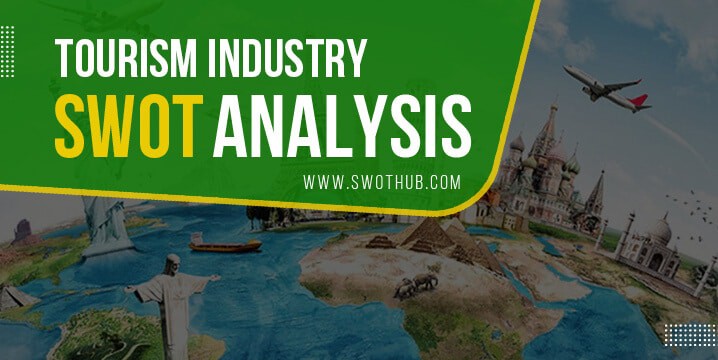
Since the pandemic, the tourism industry has been gaining popularity, and more travelers want to see the world again. A Tourism Industry SWOT Analysis is essential to see how lucrative this industry has become. Any industry that directly supplies goods or services to enhance business, enjoyment, or leisure activities away from home is included in the tourism sector. Tourism’s significance stems from the multiple benefits and advantages to every host country.
The Travel & Tourism market report, according to statista.com , comprises all travel deals bought via online travel agencies, a provider’s website, at a travel agency, or by phone has a global revenue of $297 billion in 2020 and is predicted to rise to $950 billion by 2026. A SWOT analysis of tourism will help to break down the travel and tourism industry.
Table of Contents
Tourism Industry SWOT Analysis Competitors
Some of the largest competitors in the tourism sector are the hotel and lodging sectors, airlines, travel agencies, cruise lines, and tour operators. These rivals’ strengths may include their well-known brand name and extensive experience in the industry. A weakness could be a severe lack of creative marketing or customer service. Emerging markets, technological developments, and collaborations could all present opportunities. Threats might be brought on by evolving consumer demands, fresh technologies, or heightened competition. These areas should be considered when reviewing the tourism industry SWOT analysis.
Tourism Industry SWOT Analysis
SWOT analysis is a method for assessing the system’s strengths, weaknesses, opportunities, and threats. This approach maximizes the strengths and possibilities while minimizing the drawbacks and risks to identify the best tourist tactics.
This Tourism Industry SWOT Analysis can achieve long-term development and success in attracting tourists, particularly worldwide. The typical SWOT analysis is insufficient in tourism and tourist research and studies. Tourism should be examined and handled as a system, without a systematic approach, all system components would be overlooked. Let us take a look at tourism’s strengths and weaknesses and how the travel industry can improve and celebrate!
Strengths of the Tourism Industry in SWOT Analysis

Strengths of the tourism industry SWOT analysis are necessary for the industry. It is impossible to meet business objectives unless one understands one’s capabilities. This strength analysis will assist you in identifying areas where you outperform your competition to improve your decision-making strategy. A SWOT analysis in tourism will help understand these strengths.
Cultural Legacy: Cultural legacy fosters respect in one’s history. It encourages peace and understanding in international tourism by appreciating and understanding different cultures. For many tourists, cultural heritage and historical sites are the primary interest. Students of archaeology and history are also vital demographics for such establishments.
Safe and Secure Place: Group activities and the presence of many people in various locations around a country provide a sense of safety and security. The secure atmosphere offers a solid foundation for every tourist location to attract more visitors. It’s because people don’t want to endanger their lives by visiting a volatile nation.
Economic Prosper: The tourism industry increases the economy’s revenue, produces thousands of employment, builds a country’s infrastructure, and creates a sense of cultural interaction between visitors and natives. The travel business is highly significant to a country’s GDP and economy.
For example, the United States travel and tourist industry contributed the most to the GDP of any country in the world, with a total contribution of 1.1 trillion US dollars in 2020.
Satisfactory Accommodation: People are also drawn to various motels and accommodations for multiple categories. Many prosperous tourist destinations have restaurant and hotel chains . They provide tourists and visitors with an excellent location to stay. As a result, it produces additional job possibilities for citizens and raises revenue for the local government.
Weaknesses of Tourism Industry in SWOT Analysis

Industry stakeholders can address the weaknesses identified in the tourism industry SWOT analysis. Some flaws can prohibit you from completing your purpose and goals; therefore, it’s well worth it if you can solve them.
Traditional Marketing Strategy: The majority of businesses in the tourist sector apply traditional marketing tactics. They are effective but have a limited reach, such as billboards, television commercials, newspaper ads, magazines, and referrals. These will not help in attracting an international audience. Only a few employ sponsored posts on various social media networks to target their specialized niche.
Poor Quality Service: When many people visit a particular location during the season, the service quality declines. We frequently hear clients complain about their unpleasant experiences with various travel agents. However, some well-known hotels , restaurants, and local travel businesses give excellent service in other places.
Seasonal Employees: Businesses in the hotel sector do not recruit personnel on a long-term basis. They give their poor staff wages and do not invest in training programs. In this industry, employee satisfaction is relatively not so good. An inconsistency in the staff also lowers the level of customer satisfaction.
Tourism Industry SWOT Analysis Opportunities

Recognizing the opportunities from the tourism industry SWOT analysis would help you act on and leverage, which may boost the success of your own company or endeavor or better understand the conditions other firms are experiencing. A tourism opportunity analysis could help understand what positive outcomes could arise if the opportunities are pursued.
Online Presence: Potential clients will be more likely to trust you if you have a solid online presence and a well-designed website. A captivating and well-marketed website will assist tour operators in deciding whether or not to do business with your organization. Social media marketing is the most effective way to identify and promote their target audience.
Unique Places to Visit: Attractions are a significant part of tourism since they attract visitors. The attractions are the locations, people, activities, and things that serve as the objects of tourists’ attention and draw them to a place. Suppose you can raise funds, work on the property, and develop a suitable location. In that case, you will attract a large number of tourists.
Eco-friendly Approach: Ecotourism refers to a manner of vacationing that adheres to environmental, social, and economic sustainability—a dedication to having a common cultural and ecological effect. If you build an eco-friendly location, you will attract environmentally-conscious visitors.
Tourism Industry SWOT Analysis Threats
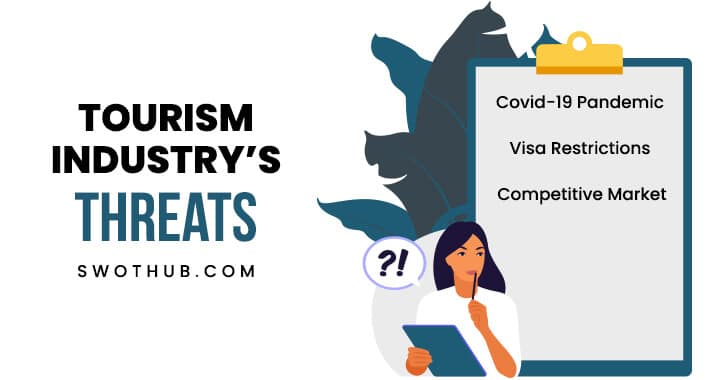
Unexpected threats can have disastrous consequences for any organization, which is why they must be considered in the tourism industry SWOT analysis. If you can forecast them, you can minimize their influence or avoid them altogether.
The COVID-19 Pandemic: The tourism sector has suffered dramatically due to the lockdown and closure of enterprises caused by the covid-19 outbreak. The restriction of hotels and restaurants as a result of the nationwide lockdown and the prohibition on air travel cost the business billions of dollars. Consequently, many individuals lost their employment, and many small firms went bankrupt.
Visa Restrictions: Visa restrictions are a crucial obstacle to the tourist business. It is pretty tough to obtain a tourist visa for several nations. Many potential clients cannot enter specific countries due to the government’s harsh immigration and visa regulations. As a result, local companies do not receive enough visitors to meet sales targets.
Competitive Market: Tourism has developed as one of the world’s largest, fastest expanding, and most competitive sectors in the 20th century. Many small enterprises have entered the fray, offering low-quality services at exorbitant costs. Customers are also dissatisfied as a result of this.
Tourism Industry SWOT Analysis Overview Template
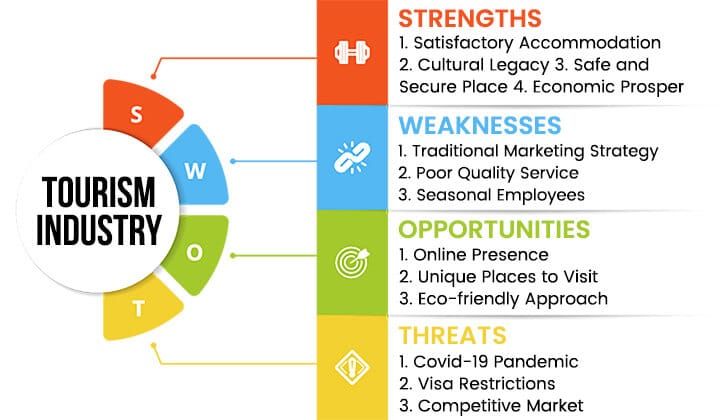
Conclusion and Recommendations for Tourism Industry SWOT Analysis
Here are a few suggestions for the future development of the tourism industry:
- Digital technology is a topic that you should consider. After the COVID-19 situation, as more employees choose remote and telecommuting, technology will increase long-term tourism.
- It will help if you focus on rebuilding the tourism sector and delivering gratifying experiences for visitors, which will be accomplished through discovering options for mass tourism.
- Increasing the supply of clean water and sanitation facilities and promoting good hygiene like hand washing would also help you provide safe tourism. We should encourage internet service providers to increase internet connections in tourist areas.
FAQs for the Tourism Industry
How profitable is the tourism industry?
The tourism industry generates immense revenue globally, contributing over $9 trillion to the global economy in recent years, and it continues to grow as people seek travel experiences.
How much money does the US make on tourism?
In the US, tourism is a substantial economic driver, contributing around $1.6 trillion annually to the economy, supporting jobs and various sectors across the nation.
What are 5 examples of the tourism industry?
Travel agencies, hotels, restaurants, airlines, cruises, theme parks, landmarks, festivals, and conferences are examples of the tourism sector. These parts shape tourism’s dynamic terrain.
Following an in-depth review of the Tourism Industry SWOT Analysis , we determined that the industry is really expanding rapidly. However, the tourism sector is a thriving enterprise, with visa limits, government rules, and other tangible and significant risks.
Moreover, the COVID-19 outbreak has shut down it all and created an unsettled atmosphere. But that’s not the end; people in this industry should work together to overcome this disaster.
Related Posts
Lowe’s swot analysis: a gratifying report.
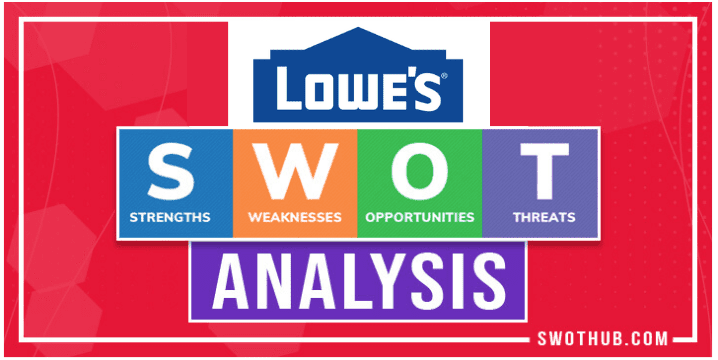

Lululemon SWOT Analysis and Lululemon Competitors: An Elite Report!
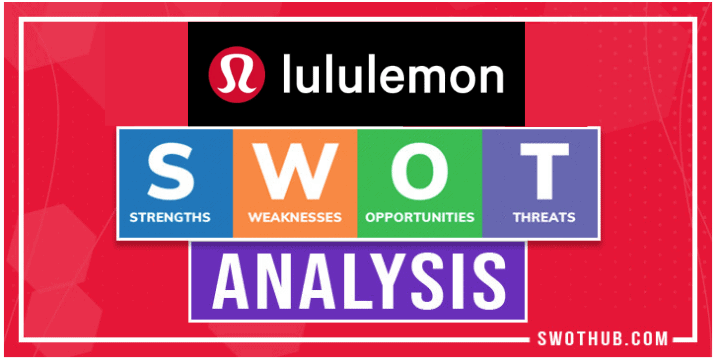
Publix SWOT Analysis: From Humble Beginnings
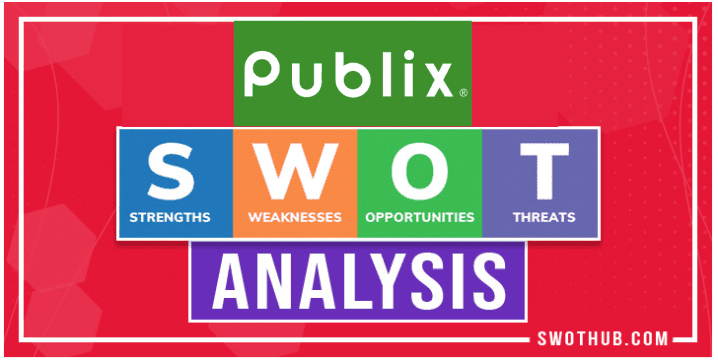
Infosys SWOT Analysis: Detailed I.T. Report
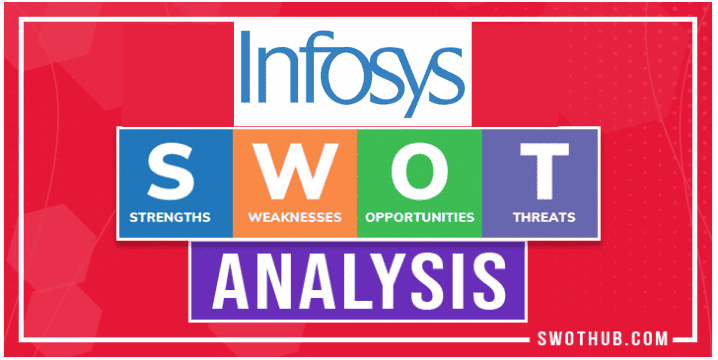

Item added to your cart
The swot of a travel agency (with examples).

Get a watermark-free, fully customizable SWOT analysis in our business plan for a travel agency
We've drafted tons of business plans for travel agencies and, far too often, business owners neglect to dedicate time and thought to crafting a strategic vision for their new project.
It's mainly because they lack the right tools and frameworks. The SWOT analysis is one of them.
What is it? Should you make a SWOT for your travel agency?
A SWOT analysis is an invaluable tool for travel agencies to navigate the complexities of the tourism industry. It stands for Strengths, Weaknesses, Opportunities, and Threats.
Developed as a framework for strategic planning, SWOT analysis helps businesses like travel agencies to dissect their internal dynamics and the external environment. The travel industry, with its ever-changing trends and customer preferences, makes this tool particularly relevant.
If you're running or considering starting a travel agency , a SWOT analysis is a crucial step. It enables you to pinpoint what you excel at (strengths), areas needing improvement (weaknesses), potential avenues for growth (opportunities), and external challenges (threats).
For example, your travel agency's strengths might include specialized travel packages or excellent customer service, while weaknesses might be a limited online presence or dependency on seasonal tourism. Opportunities could emerge from trends like eco-tourism or wellness travel, whereas threats might include economic downturns or travel restrictions.
Travel agency owners often undertake a SWOT analysis when launching new services, responding to market shifts, or facing operational hurdles. It provides a structured way to assess both the business and the broader travel landscape.
Understanding these four aspects can lead to better strategic decisions, helping prioritize efforts and develop plans that leverage your strengths and mitigate your weaknesses.
For anyone embarking on a new travel agency venture, a SWOT analysis is not just beneficial; it's a strategic necessity. It assists in recognizing your agency's unique selling points, areas requiring more investment or improvement, and external factors to watch out for.
While a SWOT analysis doesn't assure success, it dramatically increases your chances by offering a clear, strategic direction for your travel agency.

How do you write a SWOT analysis for your travel agency?
Filling out a SWOT analysis for your travel agency can seem daunting, particularly when you're attempting to foresee potential strengths, weaknesses, opportunities, and threats in the dynamic travel industry.
Engaging in comprehensive market research and perusing travel industry reports is crucial. These resources offer valuable insights into travel trends, customer preferences, and competitive dynamics.
Interacting with other travel agency owners or travel experts is also advantageous. Their practical experiences and insights can provide perspectives that are not always evident in industry reports.
Remember, the essence of a SWOT analysis is not to predict the future with absolute certainty but to equip you with a strategic approach to face it.
Reflect on the unique elements your travel agency brings to the industry.
Perhaps you specialize in exotic destinations that are not mainstream, or you have strong partnerships with reputable travel providers. Your strength might be in an experienced team with deep knowledge of travel planning, or you may offer innovative travel packages that stand out in the market.
These are internal factors that can set your travel agency apart from others.
Identifying weaknesses demands honesty and introspection.
You might face limitations in marketing budgets, affecting your ability to reach a broader audience. Lack of experience in certain types of travel, high competition in your chosen niche, or dependency on a specific market segment could be potential weaknesses.
These areas may require strategic planning, additional resources, or diversification of your services.
Opportunities
Opportunities are external elements that your travel agency can capitalize on.
For example, a rising trend in eco-tourism or adventure travel could be an opportunity. Collaborating with local businesses for travel packages, or exploiting a gap in the market, like offering unique cultural experiences, can be advantageous. Additionally, technological advancements in booking systems or virtual travel experiences could open new avenues for your business.
Threats are external challenges that could impact your travel agency.
These might include changes in travel regulations, economic downturns affecting travel spending, increased competition, especially from online travel platforms, or shifts in travel preferences due to global events like pandemics or climate change.

Examples of Strengths, Weaknesses, Opportunities and Threats for the SWOT of a travel agency
These strengths and opportunities can be leveraged to improve the profitability of your travel agency .
More SWOT analysis examples for a travel agency
If you're creating your own SWOT analysis, these examples should be useful. For more in-depth information, you can access and download our business plan for a travel agency .
A SWOT Analysis for a Luxury Travel Agency
A luxury travel agency specializes in providing exclusive, personalized travel experiences. Its strengths include access to high-end accommodations and unique, once-in-a-lifetime activities. The agency benefits from a knowledgeable team that offers expert advice and tailors travel plans to individual preferences. Strong relationships with premium service providers ensure a high level of quality and exclusivity in its offerings.
One weakness may be the high cost of luxury travel, which can limit the agency's client base to a relatively affluent demographic. Dependence on a small, high-income market segment makes the business vulnerable to economic fluctuations. Additionally, the complexity of organizing bespoke travel experiences can be labor-intensive and time-consuming.
Expanding into emerging luxury markets, such as eco-tourism or wellness retreats, can attract new clients. Collaborating with influencers in the luxury travel sphere can enhance brand visibility. Leveraging technology to provide virtual tours or augmented reality experiences can enhance the planning process and attract tech-savvy travelers.
Economic downturns can significantly impact the luxury travel market. Competition from online travel platforms offering luxury experiences at competitive prices is a growing threat. Additionally, global events such as pandemics or political instability in popular destinations can disrupt travel plans and affect business.
A SWOT Analysis for an Adventure Travel Agency
An adventure travel agency stands out with its wide array of adrenaline-pumping activities like hiking, diving, and mountain climbing. Its strengths include expert guides, access to remote and exotic locations, and tailored adventure packages. The agency's focus on sustainable tourism practices appeals to environmentally conscious travelers.
The niche nature of adventure travel limits its appeal to a specific client base, primarily younger and physically active individuals. The risks associated with adventure activities require comprehensive safety measures and insurance, adding to operational costs. Seasonal variations in weather can impact the availability of certain activities.
Developing partnerships with local communities can create unique, authentic experiences and foster sustainable tourism. Expanding the range of activities to include less intense options can attract a broader audience. Utilizing social media to showcase thrilling travel experiences can increase brand visibility and appeal to younger demographics.
Changes in environmental conditions and natural disasters can disrupt travel plans and destinations. The rise of DIY adventure planning through online resources is a competitive challenge. Additionally, fluctuations in travel regulations and global health concerns can significantly impact the adventure travel sector.
A SWOT Analysis for a Budget Travel Agency
A budget travel agency's primary strength lies in its affordability, appealing to cost-conscious travelers. It offers a variety of budget-friendly packages, including low-cost flights, accommodations, and tours. The agency benefits from strong negotiation skills to secure deals and discounts for its clients.
The focus on low-cost options may limit the quality of travel experiences offered. The agency faces intense competition from online booking platforms and other budget travel agencies. Limited profit margins on budget travel packages can challenge the financial sustainability of the business.
Expanding services to include budget-friendly, off-the-beaten-path destinations can attract travelers looking for unique experiences. Collaborating with budget airlines and hostels for exclusive deals can enhance package attractiveness. Embracing digital marketing and online booking platforms can streamline operations and reach a wider audience.
Economic downturns can lead to reduced travel spending, even among budget-conscious travelers. The rapid change in travel trends and consumer preferences requires constant adaptation. Competition from self-booking options and travel apps offering low-cost solutions is significant.

- Choosing a selection results in a full page refresh.
- Opens in a new window.
Need help reading on this site?
Text-to-speech reader:
Business Guidance
Conducting a SWOT Analysis
Defining your usp.
- Tips for preparing for networking events
- Overseas marketing platforms
- Selling to the International Market
- Top 10 Tips for Participating in a Trade Show
- Top 10 Tips for Hosting a Fam Trip
A SWOT analysis (strengths, weaknesses, opportunities and threats) is a simple tool to help you gather your thoughts as you review your business and the industry around you. It divides an overall analysis into internal issues – strengths and weaknesses) and external issues (opportunities and threats).
Put yourself in your customer’s shoes. Step back from your business and carefully scrutinise what your customers really want. What would make them return again and again to your business and ignore your competition? The answer might be quality, convenience, reliability or customer service. Remember, price is rarely the only reason people buy.
Remember to consider the opportunities that lie at your doorstep. What can you utilise in your surrounding area to add depth to your product offering? Does your business share a story with an iconic attraction? Is it located in an area of natural beauty? Is there an annual music event that you could tie in with?
SWOT Analysis Table
Europe PMC requires Javascript to function effectively.
Either your web browser doesn't support Javascript or it is currently turned off. In the latter case, please turn on Javascript support in your web browser and reload this page.
Search life-sciences literature (44,148,280 articles, preprints and more)
- Free full text
Tourism in the COVID-19 Pandemic: A Perspective with Swot Analysis
Author information, orcids linked to this article.
- Fernando I | 0000-0001-9487-5569
Preprint from SSRN , 26 Jan 2021 https://doi.org/10.2139/ssrn.3772537 PPR: PPR274876
Abstract
Free full text .
PPRID: PPR274876 EMSID: EMS115369 SSRN preprint, version 2, posted 2021 January 27 https://doi.org/10.2139/ssrn.3772537
Affiliations
- 1. Department of Management Sciences, Faculty of Management, Uva Wellassa University of Sri Lanka, Sri Lanka
Copyright and license information
Copyright notice
This preprint is made available via the Europe PMC open access subset , for unrestricted research re-use and secondary analysis in any form or by any means with acknowledgement of the original preprint source.
Over recent history, a huge number of diseases affected the human race, whereas the Novel Coronavirus or Covid-19, remains the utmost noticeable pandemic disease. The virus spreads with a distinct composition with a substantial concentration whereas people around the biosphere were locked, imposed social distancing rules, and restricted human mobility. Tourism considered a vital economic sector and contributes foreign exchange earnings for a large number of countries. Tourism bonds people with nature, cultures, livelihood, and entertainment by inspiring lives. Consequently, international tourist arrivals have been declined by 70% to 75% ratio during the year 2020, within the first and second waves of the Covid-19 Pandemic. Since the sector is more vulnerable to external environmental shocks, the outcome of this downturn is severely affecting numerous economies, specially where the main foreign exchange earnings is Tourism. Therefore, the author discusses the main highlights of the downturn, followed by Strengths, weaknesses, Opportunities, and Threats (SWOT Analysis) as a way forwarding strategy for the Tourism in the Pandemic.
Keywords: Covid-19 Pandemic, economic downturn, external environmental shock, SWOT analysis, Tourism
Introduction
In known history, a large number of diseases affected the human race, whereas the novel Coronavirus or COVID-19, remains the most prominent pandemic disease in the recent past. The virus spreads with a distinct composition with a considerable intensity whereas people around the world were locked to their own houses, imposing social distancing rules and restricting human mobility. According to scholars, ( Li et al., 2020 ) at its outset, COVID-19 spread from a Seafood market located in Wuhan-Hubei Province, then spread among Hubei province to the whole of China. This sudden shock leads the medical sector and scientific community around the globe to search for a solution whereas the hotspots were locked down. A huge number of patients were reported from 58 different countries within three months of its spread, which later created a terrifying pandemic for the entire globe ( Li et al., 2020 ). Novel Coronavirus first reported in the latter part of the year 2019, continued the first wave during 2020, and later created a severe vicious second wave around the world, where affecting severely by destructing the economies around the world. As a result, the social activities of the human was restricted by imposing strict rules, due to the high ratios of positive cases. According to Huang et al., (2020) , the virus is particularly fatal for the elderly community and people with the weaker immune system.
According to the World Health Organization (WHO), the mechanism of transmitting COVID-19 between people takes place in many different forms, through direct communication with the carrier of the disease or through the physical touch of a surface or an object that has contacted by the carrier ( Zhao et al., 2020 ). Therefore, medical advice recommended to check up on any of the objects that consist of continuous hand washing, hand and surface sanitizing, and in addition restricted touching the face frequently. Moreover, continuous usage of a protective face mask and the maintaining of a reasonable gap of more than a meter between human gatherings. In addition to environmental controls reflected in the establishment of appropriate spaces, to guarantee that individuals do not mix or gathering for a narrow location ( Zhao et al., 2020 ).
Therefore this article focus of a perspective of the Global Tourism behavior during Covid-19 pandemic. Moreover, the author has incorporated a Strengths, weaknesses, Opportunities, and Threats (SWOT) analysis for the Global Tourism within the Pandemic.
Tourism as a Vital Economic Force
Tourism counts as one of the emerging economic sectors and contributes as a main source of foreign exchange earnings for a large number of countries including developing economies ( Fernando, 2015 ; Fernando, 2020 ). Tourism is a collection of activities, services, and industries that deliver a travel experience comprising transportation, accommodation, eating and drinking establishments, retail shops, entertainment businesses, and other hospitality services provided for individuals or groups traveling away from home ( UNWTO, 2020 ). Further, it bonds people with nature and natural environment, different cultures, livelihood, entertainment by inspiring lives ( Fernando and Long, 2012 ; Fernando, 2015 ).
Major reasons facilitate expeditious global tourism growth as such; increased leisure, Greater awareness with a clustered travel programs, Greater prosperity with high expending power, Increased availability of package holidays, Growth of internet/web sources and social media, and enthusiasm to visit culture around the globe Increased number of vehicle ownership and that leads to giving greater freedom ( Fernando, 2015 ; Fernando, 2020 ). Herein, Table 1 illustrates the growth of tourism arrivals according to World Tourism Organization (WTO) during recent years.
Source: World Tourism Organization (UNWTO), International Tourism Highlights 2019 Edition
According to the World Travel and Tourism Council (WTTC) in 2019, Travel & Tourism’s direct, indirect, and induced impact accounted for 8.9 Trillion USD (or 10.3%) contribution to the global GDP. This significance highlights further by generating 330 million employments around the world and accounted for 1 in every 10 jobs around the world.
Furthermore, during the year 2019, 949 billion USD capital investments accounted within the tourism industry ( WTTC, 2020 ). Interestingly, the massive contributions indicate the significance of global tourism to the economic development of the world economy in the recent past. Tourism contributes drastically to the economic growth in various industries from hospitality, transport, Events, construction, and retail, to small businesses such as restaurants, homestays, bars, cab services, and tourism agents. According to WTTC, within the year 2019, the travel and tourism sector expanded in 3.5% ratio in the world statistics, by contributing tremendously. Moreover, the sector contributes over 330 million jobs in the world accounting for about 10% of total employment all around the globe ( WTTC, 2020 ).
Covid-19 Pandemic as an “External Shock”
The Covid-19 pandemic has changed the world in every imaginable respect and has impacted heavily on all individuals and on every industry, mainly minimizing the people mobilization, including international travel, tourism demand, and hospitality industry ( Chang et al., 2020 ). At present, the world is facing an unprecedented global health, social and economic emergency as a result of the novel Corona Virus spread. The impact of the Pandemic will affect almost all industries whereas, Travel and Tourism are among the most affected sectors due to the nature of the social gathering, social contact, and leisure activities. UNWTO predicts a massive fall in international demand amid global travel restrictions among all destinations around the world, including many borders fully closed, some famous cities, and tourism destinations locked down to contain the virus. According to ( Chang et al., 2020 ), the tourism, hospitality, and travel industry are some of the world’s largest employers, together with the energy industry, although, unlike the energy industry, the sector is less of a necessity. Therefore the Tourism sector is more sensitive and vulnerable to significant shocks or external shocks as the Covid-19 Pandemic.
The most recent issue of the UNWTO World Tourism Barometer indicates the International tourist arrivals fell by 72% during the January-October 2020 period compared with the same period of the previous year (the year 2019), curbed by slow virus containment due to the high spreading of the disease, low traveler confidence or no-confidence at all to travel and restrictions on travel or locked-down/social locked-down due to the pandemic ( UNWTO, 2020 ). Since the sector is more vulnerable to external environmental shocks ( Fernando and Long, 2012 , Fernando 2015 ), the outcome of this downturn is severely affecting most of the economies, specially where the main foreign exchange earning dominated by Tourism. According to UNWTO statistics, Asia and the Pacific accounted 82% decrease in tourist arrivals, the Middle East recorded a 73% decline, Africa recorded a 69% drop, and Europe and the Americas declined by 68% during January-October 2020 period ( UNWTO, 2020 ).
Pandemic and the downturn of Tourist arrivals
Consequently, international tourist arrivals have been declined by 70% to 75% ratio during the year 2020 within the first wave and second wave of the Covid-19 Pandemic. Further, international tourism shows a downturn to the volumes of 30 years back due to this astonishing declining ratio ( UNWTO, 2020 ). This highlights the pandemic results merely on the tourist arrivals, subsequently resulted in the tourism income or foreign exchange earnings of a destination. According to the UNWTO World Tourism Barometer, Pandemic accounted for a 22% decline in tourist arrivals in the first three months, January –February – March 2020 within the virus spread along with the world, by starting from Wuhan-China to all over the destinations along with the globe ( UNWTO, 2020 ). Figure 1 illustrates the percentage change of Tourist arrivals during the months, January – February –March, in the year 2019 compared to the year 2020.

( Source : UNWTO, 2020 )
As a result of the first and subsequent waves of the Covid-19 during the year 2020, travel and tourism have literally come to a halt, and the economic activities of the airline industry and hospitality sector have been reduced to a small fraction of what they used to be prior to the pandemic. While some economies are gradually reopening, the overall situation remains volatile due to the high contagiousness of the virus and the lack of immediate treatment or vaccine. According to the UNWTO World Tourism Barometer, almost 100% of the global destinations have announced travel restrictions as a response to the Covid-19. Moreover, in a global context, 97 destinations or 45% of the destinations have totally or partially closed their borders for international tourists, whereas 65 destinations (or 30%) have suspended totally or partially their international flights. Further, 39 destinations, or 18% out of the total are implementing these guidelines in a differentiated manner, as stated by the UNWTO, banning the entry for foreign passengers from specific countries or regions ( UNWTO, 2020 ). Therefore, the economies that are highly surviving in the tourism receipts or foreign exchange will be in a massive trauma due to the travel restrictions. Figure 2 illustrates the gradual drop in International tourist arrivals within the months January-February –March 2020 with the first wave of the Covid-19 pandemic.

( Source: UNWTO, 2020 )
Pandemic and the Economic Downturn
In history, a significant number of viruses propagate with viral sources worldwide affecting the human body and changing the impacts, mostly the personal immunity will be the survivor. Despite that, Novel Coronavirus or Covid-19 remains the most prominent pandemic disease, much similar to Spanish flu in this respect, since the virus spreads with a distinct composition with considerable intensity ( Fernando et al, 2020 ). Herein throughout history, with varying intensities, different pandemics had affected the global Tourism and Hospitality sector. On that contrary, Table 2 is an illustration of recent pandemics and the influences on global tourism.
Source: UNWTO, 2020
Table 2 demonstrates how a crisis impacts the sector, or how long it will take to arrive at the normality for the sensitive industry like Hospitality and Tourism. Descriptively, the global economic crisis in the year 2009 devoted almost two years duration (19 months) to return previous volumes, whereas the most affected region, Europe, got 29 months duration for the same.
Moreover, the crisis or disaster impact in some cases is problematic to measure economically, specially the social negative externalities. As a sensitive industry, tourism assigns value to various types of assets; climate, fresh air, scenic beauty, waterways, biodiversity, cultural artifacts, landscape as such ensuring the development of less rich areas ( Iordache et al., 2010 ), and nature-based niche markets; Agro-tourism, Tea tourism, gem-minerals and rural tourism ( Fernando et al, 2017 , Pattiyagedara and Fernando, 2020 ). Despite these values, the Covid-19 Pandemic will provide a massive range of downturn to the sector, where the sector itself bonding people-to-people in every aspect. The benefits of tourism are widespread, whereas promoting inter and intra-regional disparity elimination, poverty reduction specially within small island destinations, urbanizing of rural, communication and technology enhancements, road development, and promoting country “Branding”. On that contrary, the main objective of tourism is to enhance the quality of the livelihood of the residents ( Iordache et al., 2010 ; Kim and Dwyer, 2003 ; Fernando, 2012 ). Due to the massive contribution from the Tourism sector as a source of foreign exchange earner in many advanced and emerging economies, according to UNWTO, the pandemic results in the following impacts; (a) Destinations that have a high share of tourism income in foreign exchange earnings, employment creation, and investments, are particularly vulnerable (b) Small Island Developing States (SIDS) might get massive economic downturns.
Therefore, this paper presents Strengths, weaknesses, Opportunities, and Threats (SWOT analysis) as a way forwarding strategy for the Hospitality and Tourism sector within the face of the Covid-19 Pandemic. Figure 3 illustrates the SWOT analysis of the global tourism within the Pandemic.

( Source: own construction)
Author presents the Strengths, weaknesses, Opportunities and Threats (SWOT analysis) descriptively for the Hospitality and Tourism sector amid the face of Covid-19 Pandemic.
Strengths within the Pandemic
- Proven resilience within historical disasters such as during the major economic crisis, Terrorist attacks
- Booming the domestic tourism within the destinations: most of the marketing programs cater to domestic travels
- Adaptation capacity to the pandemic such as medical, safety, and hygiene safety measures, training of medical practitioners
- Promoting Special Interest Tourism (SIT): Tea Tourism, Ayurvedic Tourism, Health and Wellness tourism, Nature-based travel
- Clustering the small groups
- More responsible tourist behavior: specially maintaining the social distance rules, health precautions, and self-sanitation
- Promoting short distance travels and tourism niche-markets
- Destination Management Organizations (DMO)’s and Government support to the Tourism sector: country branding, image building, and “tourism bubble concept”
Weaknesses within the Pandemic
- High risk for MICE tourism: specially the Events segment
- Highest impact for Air traveling results major Airline Companies to collapsed, loss of employment and income
- Major global tourist markets and hotspots were highly affected: specially the European continent
- Demand for the sector reduced due to social distancing rules imposed, unsafety during Air travel, and regional factors
- Tourist perception towards the traveling: perceive as a high risk
- Residents perception towards the foreign travelers: perceive as a high risk
Opportunities within the Pandemic
- The upbringing of innovating practices: virtual tours and out-door entertainments
- Investing more in health and wellness tourism, Ayurvedic Tourism, Tea tourism
- Novel innovative business models: hybrid models with human touch and technology
- Promoting sustainable tourism: nature travels, rural tourism niche markets
- Diversification of the domestic tourism segment: nature trails, bio-diversity, rural tourism, Agro-farming related tourism
- Small Island destinations: innovative focus and promotion of niche-markets
- Orientation for less-identified niches as novelties: lagoon based travels, Spiritual tourism segments
- Managing events innovatively: promoting outdoor events, outdoor weddings and functions, culture trails
- Social media platforms and online media promotions
- Perception on lifestyle : more directs for healthy food patterns, traditional way of living, explore more nature and fresh air
Threats within the Pandemic
- Global Economic Recession
- Direct and indirect employment loss in tourism: Tour guides, Homestays, Hotels, Event Planners, etc.
- Downturn of the global business: specially Micro, Small and Medium Enterprises (MSME)
- Lower disposable income of the people: diminishing the travel intention, less demand for leisure
- Negative perception: due to less-prediction of the virus spreading, high contagious virus
- Social distancing, travel restrictions, and locked-down status of the major destinations
- Uncertainty and social panic: vaccine to Covid-19
The author wishes future researchers would cater towards the country-specific determinants within the SWOT analysis amid the economic downturn of the Pandemic. Therefore this SWOT analysis could be a baseline for a more extensive destination-catered empirical research work on the Tourism industry within the face of Pandemic.
Tourism considered as a vital economic force as well a sector which could ties people with nature, cultures, livelihood, and entertainment by inspiring the lives. Due to the Covid-19 Pandemic, consequently, global tourist arrivals have been dropped by 70% to 75% ratio during the year 2020. Tourism sector is more vulnerable to the external environmental shocks as such Pandemics, civil war, Disasters etc., the outcome of this downturn is severely affecting numerous economies around the world, specially where the tourism income plays a significant role within the foreign exchange earnings. Hence, this article is a perspective where the author discusses the main highlights of the Tourism downturn in global context, followed by Strengths, weaknesses, Opportunities, and Threats Analysis (SWOT Analysis) as a way forwarding strategy for the Tourism in the Pandemic.
Author Information
kl.ca.uwu@filami
Author is a Professor in the discipline of Management, attached to the Department of Management Sciences, Faculty of Management, Uva Wellassa University of Sri Lanka.
- Chang C , McAleer M , Vicente R . A Charter for Sustainable Tourism after COVID-19 . Sustainability . 2020 ; 12 : 3671 .
- Fernando Imali N . What competitive strategies way forward the regional competitiveness? A comparative Economic approach to Sri Lankan Tourism . International Journal of Business and Management . 2015 ; 10 ( 4 ): 178 .
- Fernando Imali N . Tourism competitiveness by shift-share analysis toway-forward Destination Management: A case study for Sri Lanka . Journal of Tourism and Services . 2020 ; 11 ( 21 ): 88-102 .
- Fernando Imali N , Long Wei . New conceptual model on cluster competitiveness: A new paradigm for Tourism? International Journal of Business and Management . Canadian Center of Science and Education ; 2012 ; 7 ( 9 ).
- Fernando Imali N . Towards an Integrated Conceptual Model on Tourism Competitiveness: Does Clustering Way Forward? International Journal of Research in Commerce and Management . 2012 ; II ( XI ).
- Fernando PIN , Rajapaksha R , Kumari K . Tea Tourism as a marketing tool : a strategy to develop the image of Sri Lanka as an attractive tourism destination . Kelaniya Journal of Management . 2017 ; 5 ( 2 ).
- Huang C , Wang Y , Li X , Ren L , Zhao J , Hu Y , Zhang L , Fan G , Xu J , Gu X , Cheng Z , et al. Clinical features of patients infected with 2019 novel coronavirus in Wuhan, China . The Lancet . 2020 ; 395 ( 10223 ): 497-506 . https://doi.org/10.1016/S0140-6736(20)30183-5
- Iordache C , Ciochina I , Asandei M . Clusters-Tourism activity increase competitiveness support . Theoretical and Applied Economics . 2010 ; XVII ( 5 ): 99-112 .
- Kim C , Dwyer L . Destination Competitiveness and Bilateral Tourism flows between Australia and Korea . The Journal of Tourism Studies . 2003 ; 14 ( 2 ): 55-67 .
- Kock F , Astrid N , Josiassen A , Assaf G , Tsionas M . Understanding the COVID-19 tourist psyche: The Evolutionary Tourism Paradigm . Elsevier Public Health Emergency Collection . 2020 November : 85 .
- Li X , Song Y , Wong G , Cui J . Bat origin of a new human coronavirus: there and back again . Science China Life Sciences . 2020 ; 63 ( 3 ): 461-462 . https://doi.org/10.1007/s11427-020-1645-7
- Pattiyagedara S , Fernando PIN . Rural Tourism Niche-market as a development strategy on rural community : Refernce to Hiriwadunna Village Track, Meemure and Heeloya Knuckles Valley Tourism Village, Sri Lanka . Sri Lanka Journal of Management Studies . 2020 ; 2 ( 1 ): 87-103 .
- UNWTO, World Tourism Barometer . Special focus on the Impact of COVID-19 . 2020 . [accessed on 23 January 2021]
- World Tourism Organization (UNWTO) . International Tourism Highlights 2019 Edition . [accessed on 23 January 2021]
- WTTC . Economic Impact Reports . World Travel and Tourism Council ; 2020 .
- Zhao S , Lin Q , Ran J , Musa SS , Yang G , Wang W , Lou Y , Gao D , Yang L , He D , Wang MH . Preliminary estimation of the basic reproduction number of novel coronavirus (2019-nCoV) in China, from 2019 to 2020: A data-driven analysis in the early phase of the outbreak . International Journal of Infectious Diseases . 2020 ; 92 : 214-217 . https://doi.org/10.1016/j.ijid.2020.01.050
- Posted January 27, 2021.
Full text links
Read article at publisher's site: https://doi.org/10.2139/ssrn.3772537
Europe PMC is part of the ELIXIR infrastructure
- Activity Diagram (UML)
- Amazon Web Services
- Android Mockups
- Block Diagram
- Business Process Management
- Chemical Chart
- Cisco Network Diagram
- Class Diagram (UML)
- Collaboration Diagram (UML)
- Compare & Contrast Diagram
- Component Diagram (UML)
- Concept Diagram
- Cycle Diagram
- Data Flow Diagram
- Data Flow Diagrams (YC)
- Database Diagram
- Deployment Diagram (UML)
- Entity Relationship Diagram
- Family Tree
- Fishbone / Ishikawa Diagram
- Gantt Chart
- Infographics
- iOS Mockups
- Network Diagram
- Object Diagram (UML)
- Object Process Model
- Organizational Chart
- Sequence Diagram (UML)
- Spider Diagram
- State Chart Diagram (UML)
- Story Board
- SWOT Diagram
- TQM - Total Quality Management
- Use Case Diagram (UML)
- Value Stream Mapping
- Venn Diagram
- Web Mockups
- Work Breakdown Structure
SWOT Analysis of Tourism Industry
SWOT Analysis of Tourism Industry provides insights on the industry's strengths, weaknesses, opportunities and threats. It is used to analyze the external and internal environments of an organization, assessing its capabilities and limitations. Additionally, this analysis helps organizations identify potential threats, identify market opportunities and devise strategies to take advantage of them. It can be used as part of a marketing strategy to identify how changes in the industry can affect the business. By using a SWOT Analysis, businesses can make informed decisions to develop long-term organisational success.
You can easily edit this template using Creately's SWOT analysis maker . You can export it in multiple formats like JPEG, PNG and SVG and easily add it to Word documents, Powerpoint (PPT) presentations, Excel or any other documents. You can export it as a PDF for high-quality printouts.
- Flowchart Templates
- Org Chart Templates
- Concept Map Templates
- Mind Mapping Templates
- WBS Templates
- Family Tree Templates
- Network Diagram Templates
- SWOT Analysis Templates
- Genogram Templates
- Activity Diagram
- Class Diagram
- Collaboration Diagram
- Component Diagram
- Data Flow Diagrams(YC)
- Deployment Diagram
- Fishbone Diagram Templates
- Object Diagram
- Sequence Diagram
- State Chart Diagram
- Use Case Diagram
Related Templates
Service Quality Evaluation in the Tourism Industry: A SWOT Analysis Approach
- Conference paper
- First Online: 01 January 2012
- Cite this conference paper

- Marianna Tsitsiloni 6 ,
- Evangelos Grigoroudis 6 &
- Constantin Zopounidis 6
Part of the book series: Springer Proceedings in Mathematics & Statistics ((PROMS,volume 31))
1988 Accesses
6 Citations
The quality evaluation of the provided tourism services constitutes the most important issue for the viability of this particular sector and the improvement of the total tourism product. This paper presents the results of a tourist satisfaction survey that took place in the island of Mykonos during the period of May–September 2009. The final sample consists of 1,026 questionnaires that were distributed to Greek and foreign tourists during their departure from the island (harbor and airport). The main objective of this paper is to evaluate tourists’ satisfaction and identify the strong and the weak points of the tourism services offered. These results may help the development of a strategic plan for the quality improvement of the overall tourism product. Beyond descriptive statistical techniques, the analysis of the collected data is based on the multicriteria method MUSA. The method is able to combine satisfaction importance and performance results and provides a SWOT (Strengths-Weaknesses-Opportunities-Threats) analysis for the whole set of the tourist satisfaction criteria. The presented analytical results reveal that the main strong points of the offered tourist product are the fame and the natural beauties of the island, as well as the high level of expenses. On the other hand, the most important weak points concern the small duration of stay, as well as the low level of satisfaction in specific service quality criteria (local transports, information, and environment).
This is a preview of subscription content, log in via an institution to check access.
Access this chapter
- Available as PDF
- Read on any device
- Instant download
- Own it forever
- Compact, lightweight edition
- Dispatched in 3 to 5 business days
- Free shipping worldwide - see info
- Durable hardcover edition
Tax calculation will be finalised at checkout
Purchases are for personal use only
Institutional subscriptions
Arabatzis, G., Grigoroudis, E.: Visitors’ satisfaction, perceptions and gap analysis: the case of Dadia-Lefkimi-Souflion National park. Forest Pol. Econ. 12 (3), 163–172 (2010)
Article Google Scholar
Bowen, D., Clarke, J.: Reflections on tourist satisfaction research: past, present and future. J. Vacation Market. 8 (4), 297–308 (2002)
Buhalis, D.: Tourism in Greece: strategic analysis and challenges. Curr. Issues Tourism 4 (5), 440–480 (2001)
De Ruyter, J.C., Bloemer, J.M.A., Peters, P.: Merging service quality and service satisfaction: An empirical test of an integrative framework. J. Econ. Psychol. 18 (4), 387–406 (1997)
Dutka, A.: AMA Handbook of Customer Satisfaction: A Complete Guide to Research, Planning and Implementation. NTC Business Books, Illinois (1995)
Google Scholar
Grigoroudis, E., Siskos, Y.: Preference disaggregation for measuring and analysing customer satisfaction: the MUSA method. Eur. J. Oper. Res. 143 (1), 148–170 (2002)
Article MATH Google Scholar
Grigoroudis, E., Siskos, Y.: A survey of customer satisfaction barometers: results from the transportation-communications sector. Eur. J. Oper. Res. 152 (2), 334–353 (2004)
Grigoroudis, E., Siskos, Y.: Customer Satisfaction Evaluation: Methods for Measuring and Implementing Service Quality. Springer, New York (2010)
MATH Google Scholar
Grigoroudis, E., Siskos, Y., Saurais, O.: TELOS: a customer satisfaction evaluation software. Comp. Oper. Res. 27 (7–8), 799–817 (2000)
Grigoroudis, E., Politis, Y., Siskos, Y. Satisfaction benchmarking and customer classification: an application to the branches of a banking organization. Int. Trans. Opera. Res. 9 (5), 599–618 (2002)
Hanim, N., Salleh, M., Othman, R.: Importance-satisfaction analysis for Tioman Island Marine Park, MPRA paper, 22679, Munich University Library (2010)
Hill, N.: Handbook of Customer Satisfaction Measurement. Gower Publishing, Hampshire (1996)
Hsu, T.-K., Tsai, Y.-F., Wu, H.-H.: The preference analysis for tourist choice of destination: A case study of Taiwan. Tourism Manag. 30 (2), 288–297 (2009)
Karakitsiou, A., Mavrommati, A., Migdalas, A., Tsiakali, K.: Customer satisfaction evaluation in the tourism industry: the case of Chania. Found. Comput. Decis. Sci. 32 (2), 111–124 (2007)
Kozak, M.: Comparative assessment of tourist satisfaction with destinations across two nationalities. Tourism Manag. 22 (4), 391–401 (2001)
Mihelis, G., Grigoroudis, E., Siskos, Y., Politis, Y., Malandrakis, Y.: Customer satisfaction measurement in the private bank sector. Eur. J. Oper. Res. 130 (2), 347–360 (2001)
Naisbitt, J.: Global Paradox. Nicholas Brealey Publishing, London (1995)
Naumann, E., Giel, K.: Customer Satisfaction Measurement and Management. Thomson Executive Press, Cincinnati (1995)
Oh, H.: Revisiting importance-performance analysis. Tourism Manag. 22 (6), 617–627 (2001)
Parasuraman, A., Zeithaml, V.A., Berry, L.L.: A conceptual model of service quality and its implications for future research. J. Market. 49 (4), 41–50 (1985)
Parasuraman, A., Zeithaml, V.A., Berry, L.L.: SERVQUAL: a multiple item scale for measuring consumer perceptions of service quality. J. Retailing 64 (1), 14–40 (1988)
Parasuraman, A., Zeithaml, V.A., Berry, L.L.: Refinement and reassessment of the SERVQUAL scale. J. Retailing 67 (4), 420–450 (1991)
Pawitra, T.A., Tan, K.C.: Tourist satisfaction in Singapore: a perspective from Indonesian tourists. Manag. Serv. Qual. 13 (5), 399–411 (2003)
Pizam, A., Neumann, Y., Reichel, A.: Dimensions of tourist satisfaction with a destination area. Ann. Tourism Res. 5 (3), 314–322 (1978)
Politis, Y., Siskos, Y.: Multicriteria methodology for the evaluation of a Greek engineering department. Eur. J. Oper. Res. 156 (1), 223–240 (2004)
Rozman, C., Potočnik, M., Pažek, K., Borec, A., Majkoviž, D., Bohanec, M.: A multi-criteria assessment of tourist farm service quality. Tourism Manag. 30 (5), 629–637 (2009)
Ryan, C., Cessford, G.: Developing a visitor satisfaction monitoring methodology: quality gaps, crowding and some results. Curr. Issues Tourism 6 (6), 457–507 (2003)
Siskos, Y., Grigoroudis, E., Zopounidis, C., Saurais, O.: Measuring customer satisfaction using a collective preference disaggregation model. J. Global Optim. 12 (2), 175–195 (1998)
Article MathSciNet MATH Google Scholar
Spreng, R.A., McKoy, R.D.: An empirical examination of a model of perceived service quality and satisfaction. J. Retailing 72 (2), 201–214 (1996)
Tonge, J., Moore, S.A.: Importance-satisfaction analysis for marine park hinter-lands: a western Australian case study. Tourism Manag. 28 (1), 768–776 (2007)
Tribe, J., Snaith, T.: From SERVQUAL to HOLSAT: holiday satisfaction in Varadero, Cuba. Tourism Manag. 19 (1), 25–34 (1998)
Truong, T.-H., Foster, D.: Using HOLSAT to evaluate tourist satisfaction at destinations: The case of Australian holidaymakers in Vietnam. Tourism Manag. 27 (5), 842–855 (2006)
Tsitsiloni, M.: Evaluating service quality and developing improvement plans in the tourism sector. Diploma Thesis, Technical University of Crete, Greece (2010)
Vavra, T.G.: Improving your Measurement of Customer Satisfaction. ASQC Quality Press, Milwaukee (1997)
Wade, D.J., Eagles, P.: The use of importance-performance analysis and market segmentation for tourism management in parks and protected areas: an application to Tasmania’s National Parks. J. Ecotourism 2 (3), 196–212 (2003)
Woodruff, R.B., Gardial, S.F.: Know your Customer: New Approaches to Under-standing Customer Value and Satisfaction. Blackwell, Oxford (1996)
Yuksel, A.: Managing customer satisfaction and retention: a case of tourist destinations, Turkey. J. Vacation Market. 7 (2), 153–168 (2001)
Article MathSciNet Google Scholar
Download references
Author information
Authors and affiliations.
Department of Production Engineering and Management, Technical University of Crete, University Campus, Kounoupidiana, GR73100, Chania, Greece
Marianna Tsitsiloni, Evangelos Grigoroudis & Constantin Zopounidis
You can also search for this author in PubMed Google Scholar
Corresponding author
Correspondence to Marianna Tsitsiloni .
Editor information
Editors and affiliations.
, Faculty of Engineering, Aristotle University of Thessaloniki, Thessaloniki, 54124, Greece
Athanasios Migdalas
, Economical and Social Sciences, University of Macedonia, Loggou-Tourpali, Naoussa, 59200, Greece
Angelo Sifaleras
, Department of Applied Informatics, University of Macedonia, Egnatia St. 156, Thessaloniki, 54006, Greece
Christos K. Georgiadis
, Department of Marketing and Operations M, University of Macedonia, Agiou Dimitriou 49, Edessa, 58200, Greece
Jason Papathanasiou
, Department of Applied Informatics, University of Macedonia, Egnatia Street 156, Thessaloniki, 54006, Greece
Emmanuil Stiakakis
Rights and permissions
Reprints and permissions
Copyright information
© 2013 Springer Science+Business Media New York
About this paper
Cite this paper.
Tsitsiloni, M., Grigoroudis, E., Zopounidis, C. (2013). Service Quality Evaluation in the Tourism Industry: A SWOT Analysis Approach. In: Migdalas, A., Sifaleras, A., Georgiadis, C., Papathanasiou, J., Stiakakis, E. (eds) Optimization Theory, Decision Making, and Operations Research Applications. Springer Proceedings in Mathematics & Statistics, vol 31. Springer, New York, NY. https://doi.org/10.1007/978-1-4614-5134-1_18
Download citation
DOI : https://doi.org/10.1007/978-1-4614-5134-1_18
Published : 19 September 2012
Publisher Name : Springer, New York, NY
Print ISBN : 978-1-4614-5133-4
Online ISBN : 978-1-4614-5134-1
eBook Packages : Mathematics and Statistics Mathematics and Statistics (R0)
Share this paper
Anyone you share the following link with will be able to read this content:
Sorry, a shareable link is not currently available for this article.
Provided by the Springer Nature SharedIt content-sharing initiative
- Publish with us
Policies and ethics
- Find a journal
- Track your research
Six trends shaping new business models in tourism and hospitality
As destinations and source markets have changed, tourism and hospitality companies have evolved too. Six key trends have shaped business models in this sector over the past decade.
About the authors
This article is a collaborative effort by Caroline Tufft , Margaux Constantin , Matteo Pacca , and Ryan Mann , with Ivan Gladstone and Jasperina de Vries, representing views from McKinsey’s Travel, Logistics & Infrastructure practice.
In accommodation, asset-light models like franchising and management have proliferated, though luxury and small-scale brands are opting out. Consolidation has driven economies of scale. Hotels are looking to reclaim their relationship with guests, and almost two decades in, home sharing is charting its own course.
In the experiences space, reinvention is the name of the game. Cruises and theme parks have both focused on attracting new demographics while fine-tuning their revenue management strategies. Experiences remains a highly fragmented, legacy sector, creating massive opportunity for those able to crack the code on aggregation.
By considering the six trends, tourism and hospitality companies can gain insights on business practices for today—and on areas of future opportunity.
Accommodation: New models and value propositions
Large hotel brands have increasingly turned away from hotel ownership, scaling their business through franchising and management instead. The move is paying off. We find there is a 0.84 correlation between a hotel company’s share of franchised properties and its net profit margin.
Not all of hospitality is embracing asset-light model, however. Luxury hotel chains have resisted the trend, largely retaining in-house ownership to control standards. And smaller brands may find that they cannot reach the economies of scale that make the math of a franchise business work—focusing instead on creating distinctive experiences on a smaller scale.
Consolidation set the stage for the past decade. Several hotel brands quickly grew their foothold in key geographies and customer segments through strategic acquisitions, achieving economies of scale along the way.
As major hotels take a breather from a series of substantial acquisitions, further mergers between large hotel brands seem unlikely. However, tuck in acquisitions to target key growth demographics, like the luxury and youth categories, are likely to continue.
Another trend on the horizon is direct booking. Long reliant on online travel agencies, hotels are looking to reclaim their relationships with customers—both to cut down on intermediary booking fees and to learn more about their guests. Hotels are encouraging direct bookings through a variety of levers, ranging from best-rate guarantees to higher reward-earnings rates and improved mobile applications. 1 For example, Hyatt offers a best-rate guarantee for booking on hyatt.com and Marriott International is growing direct bookings. For more, see “Marriott sees record direct bookings at its hotels,” Skift, May 4, 2022.
Home sharing is here to stay. The segment has grown from 10 to 14 percent of booking value between 2017 and 2023, experiencing ups and downs in profitability along the way.
Recently, home sharing has positioned itself as more than a stand-in for traditional hotels. Airbnb’s recent advertising campaign “Get an Airbnb” leaned into the differences of home sharing from other hospitality offerings, emphasizing the space and privacy that renting a house can offer. 1 Samantha Shankman, “‘Get an Airbnb’ campaign challenges hotels,” Skift, August 30, 2023.
Home-sharing companies have also become a key distribution channel for smaller hotels, as they can offer more control over inventory and lower fees than other channels. In 2019, Airbnb reported a 152 percent increase in the number of rooms available for booking through its platform in boutique hotels, bed and breakfasts, and resorts. 2 “More hotels are using Airbnb,” Airbnb news release, January 16, 2019.
Experience providers: New segments and revenue streams
Cruises may only account for 2 percent of the overall travel and tourism market, but they have achieved 6 percent yearly revenue growth in the past decade. 1 McKinsey analysis of publicly listed tourism and hospitality companies’ Form 10-Ks. Attracting new travelers and providing new experiences have been key growth strategies.
Luxury hotels are capturing the new-to-cruising segment with the launch of yacht brands, purposefully positioned as a distinct experience from traditional cruises. Meanwhile, millennials are challenging stereotypes about cruising: of all cruise passengers, they are the demographic most likely to say they plan to cruise again (88 percent). 2 State of the cruise industry 2023: September 2023 update, CLIA, September 2023.
In parallel, cruises have fine-tuned their profitability through economies of scale and new revenue streams. Megaships have become the new normal, as ships with over 3,000 berths have grown from 27 to 47 percent of the global cruise fleet since 2015. Ancillary purchases such as onshore excursions and onboard casinos have also become a major source of growth, now accounting for 30 percent of revenue on average. 3 Calculated using the weighted average based on 2023 Form 10-Ks statements of publicly listed cruise companies.
Theme park attendance has grown 3 percent a year over the past decade, as theme park providers capitalize on new demographics and refine their revenue management strategies. 1 Global attraction attendance report , joint report from AECOM and Themed Entertainment Association, 2019.
Two new groups of visitors in particular are powering growth. First, the Asia–Pacific region accounted for much of the growth in theme park attendance in the past decade: of the total number of new visitors between 2013 and 2018, 57 percent were from Asia. Second, millennials are heading to parks in greater numbers, and not just for their children. A similar proportion of millennial parents (78%) and millennial nonparents (75%) say they are interested in going to a theme park. 2 Morning Consult survey, 2,201 participants, June 14–19, 2018.
To increase value from growing attendance, theme parks have become increasingly sophisticated in the field of revenue management. Demand-based pricing, tiered annual passes, and skip-the-line fees are all poised to go from pioneering to widespread practices.
Experiences are increasingly important to travelers, but the segment remains a highly fragmented space. Operators of activities ranging from walking tours to snorkeling outings tend to be small businesses with a limited digital presence.
This has created an opportunity for tech-forward companies to help travelers discover and book experiences. Destination marketing organizations have long played a role in this. For instance, VisitScotland helps visitors discover interesting activities like attending Harry Potter filming locations and whiskey tastings.
Several private companies that offer online discovery and booking platforms for travel activities, like Viator, GetYourGuide, and Klook, have achieved considerable growth in the US, European, and Asian markets. 1 Yeoh Siew Hoon, “GetYourGuide gets into pole position to win in $250b experiences market,” WIT, September 20, 2023. GetYourGuide grew its revenue fourfold between 2022 and 2023, Viator revenue was up 49 percent for the same time period, and Klook reported twice as many new customers in 2023 as in 2019. 2 “Klook completes US$210 million funding, embarks on a new era of profitable growth,” Klook news release, December 6, 2023; Mitra Sorrells, “With speculation of a sale in the air, Tripadvisor reports record revenue driven—again—by Viator,“ Phocus Wire, February 14, 2024.
Looking forward: Strategies to stay ahead of the curve
Where does this leave tourism and hospitality companies? Companies in any given sector tend to follow a power law curve : a small share of companies account for an outsize portion of both profits and losses. The tourism and hospitality sector is no different.
Over the past decade, publicly listed accommodation and experience providers grew revenue at 3 percent and 4 percent, respectively, roughly in line with global GDP growth. Accommodation providers increased their profits by five percentage points, while experience providers remained at an 18 percent average profit margin.
As stakeholders gear up for the next decade, there are things that businesses across the sector can do to sustain their hard-won growth—and profits. Moving forward, three strategies in particular can help tourism and hospitality companies stay on the leading edge of innovation.
Unbundle offerings
Hotel and experience providers can take a page from the airline playbook by unbundling rates and letting consumers pay for the exact experience they want. For example, at the time of booking, hotels can present guests with an individually priced bundle for a room on a higher floor, including breakfast and free parking—features that the guest’s past behavior suggests they would particularly value. Ensuring that guests can find their ideal room can lead both to increased revenue and increased satisfaction. A major hotel brand reported that guests chose to spend an additional $22 per night, on average, to customize their hotel room to their liking. 1 “IHG Hotels & Resorts revolutionizes booking experience through next-gen cloud solutions,” InterContinental Hotels news release, September 12, 2023.
Cross-sell exclusive experiences
For accommodation and transportation companies, partnering with experience providers to cross-sell a full journey provides an opportunity to tap into a growing area of traveler spending—and a chance to deepen the relationship with customers as a vacation creator. For example, airlines can partner with museums to offer discounted rates if booked at the time of the flight, or hotels can partner with a historical site nearby to offer early-hours admission. For uptake rates to become significant, the partnership needs to add value beyond mere cross-selling. Offering features like insurance or an option to buy now and pay later is one way to add value; creating a distinctive experience like a combined train and historic hotel journey is another.
Embrace a data-powered strategy
Tourism and hospitality entities individually hold a treasure trove of untapped data. Take Paris: hotels may see a surge in bookings for the “shoulder season.” Experience aggregator platforms might see that street food tours have attracted rising interest. Social media might reveal that a particular neighborhood is exploding in popularity. What special guest experiences could be created by combining these insights? Stakeholders can unlock new revenue streams by thinking through what data they hold that can be of value to others. More broadly speaking, combining multiple sources of data can help guide a strategy of unbundling and cross-selling to create more gratifying and pertinent experiences for travelers around the world. Embracing data isn’t just smart—it’s the future of travel.
Caroline Tufft is a senior partner in McKinsey’s London office, Margaux Constantin is a partner in the Dubai office, Matteo Pacca is a senior partner in the Paris office, Ryan Mann is a partner in the Chicago office, Ivan Gladstone is an associate partner in the Riyadh office, and Jasperina de Vries is an associate partner in the Amsterdam office.
The authors wish to thank Abdulhadi Alghamdi, Alessandra Powell, Alex Dichter, Cedric Tsai, Diane Vu, Elisa Wallwitz, Lily Miller, Maggie Coffey, Nadya Snezhkova, Nick Meronyk, Paulina Baum, Peimin Suo, Rebecca Stone, Sarah Fellay, Sarah Sahel, Sophia Wang, Steffen Fuchs, Steffen Köpke, Steve Saxon, and Urs Binggeli for their contributions to this article. The authors also wish to thank Mabrian for providing data.
Explore a career with us
Related articles.

How the world’s best hotels deliver exceptional customer experience
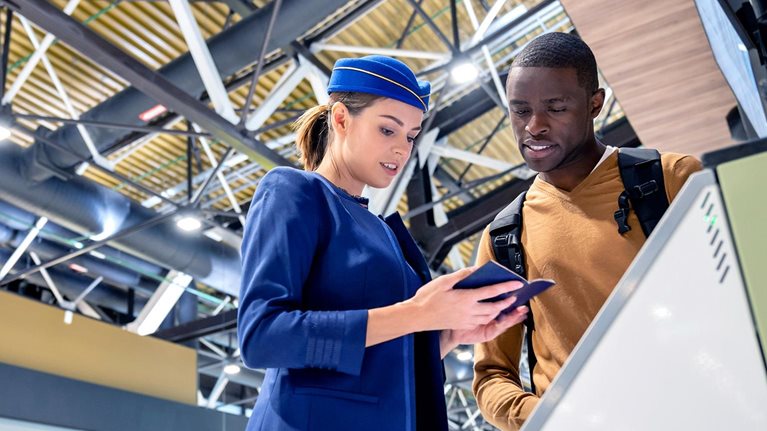
What AI means for travel—now and in the future
SWOT Analysis of Tourism Industry
The tourism industry is a type of business where people get out of their casual environment and visit someplace different for leisure activities. The purpose of tourism is to refresh your mind by changing the environment, away from home, business, and work environment.
The tourism industry is a combination of many sub-industries like Travel companies, hotels and restaurants , lodging, transport business, attraction, and many other small businesses. The tourism and travel industry plays a significant role in the economy of a country.
According to statista.com , the tourism industry combined with the travel business contributed approximately 2.9 trillion US dollars to the global economy by the end of 2019. The tourism industry has added approximately 580.7 billion US dollars to the US economy alone.
When we talk about the countries and cities where the share of travel and tourism industry has added the most, Macau is the top of the list.
Today we’ll discuss the swot analysis of tourism industry, how the internal strengths/weaknesses, and the external threats/opportunities the tourism industry has to face.
Here’s the swot analysis of tourism industry;
Table of Contents
Strengths of Tourism Industry
Following are the major strengths of the tourism industry.
Cultural Heritage
Cultural heritage and historical places are the main centers of attention for many tourists. The history and archeology students are also the target market of such places.
The ancient temples in India and Thailand, the Great Wall in China, the Egyptian Pyramid, K-2 in Pakistan, Himalayas mountain, ruins of ancient Greeks, Stonehenge in the UK, and many other places around the world are a cultural heritage that attracts thousands of tourists every year.
Local Festivals
The other thing that comes along with cultural heritage is the local festivals. They’re different in different parts of the world. Some festivals are so unique that attract tourist to have a real-life experience of those festivals.
For instance, the New Year festival in China, the colors of Holi in India, American Orgi, and wild bull race in Spain, Pamplona’s festival, and many other festivals. Such festivals and their unique history provide a unique experience to the people. It doesn’t matter whether it’s right or wrong and good or bad, they’re unique in their way.
Safe Environment
When hundreds and thousands of people are gathered at one place and celebrating the festivals. They’re moving around, meeting with different, and enjoying the company of their friends and relatives. It gives the impression of a safe environment. The safety of the environment attracts more people towards it, and the tourism industry keeps on multiplying.
Accommodation Facilities
As I’ve discussed earlier that the tourism industry works in collaboration with other businesses as well. Different kinds of lodgings and accommodations for different types of people also attract people.
If a tourist spot has luxury hotels, it’s good for business and rich people. Some of the successful tourist places offer accommodation facilities for all types and categories of people.
Enough Resources to Produce Quality Products
One of the most important advantages of the tourism industry is that it increases the GDP growth of your country. When businesses and people in your country have sufficient capital and resources, then they would be able to produce quality products. When they start offering quality products and services to the customers, it would bring more people. The cycle of productivity and growth keeps on increasing.
Economic Growth
The tourism industry plays a very important role in the GDP and economy of a country. In 2019, the tourism industry along with the travel business single-handedly added 2.9 trillion dollars to the world’s economy. The countries that have realized the significance of the tourism industry, earn billions of dollars of revenue annually from it.
Traveling Convenience
A country with a strong infrastructure of roads, railways, and airports would attract more people. It’s because traveling convenience is also a very important aspect of the tourism industry. There could be very beautiful places, but there are no roads to reach there. People usually don’t take risks in their lives where there are no roads. Successful tourist countries have a well-established system of transport.
Diverse Culture
People speak different languages across the world and there’s a strong cultural diversity. It also includes different types of lifestyle, clothing, eating, festivities, and the whole social setup. It’s different everywhere. Some cultures are open and moderate that they’re willing to accept any good new thing. Such openness attracts a lot of people towards it.
Weaknesses of the Tourism Industry
Below are the weaknesses of the tourism industry.
Less Management Skill
As we have established the fact that tourism is a combination of different types of business. It means that you have to bring different businesses to the table to work for the same common goal. The objective would growth of the tourism industry.
It may seem simple and easy, but it requires a huge managerial skill. It’s because different businesses have different objectives and they may not agree with your plan. We don’t see a high level of professionalism often.
Lack of Innovation
The tech development and progress that we see in different fields like transport, hotels, and luxury are all moving in a different direction. There’s no coherence among all of them. We can safely say that it lacks innovation and creativity.
Lack of Quality Service
Some hotels and restaurants, airlines, and local travel companies provide quality service in some countries. Often we hear people complaining about their bad experience that they had with the different traveling agencies. Many tourism agencies working in different countries and they charge a very amount for their services. Very few of them provide quality services to their clients.
High Turnover Rate
The employees’ turnover rate is very high in the tourism industry. It’s because the work pressure is very high during the season, and pay is very low. The reason people accept such a job is to fill the gap in their careers. They’re always looking for a better opportunity. Whenever they find it, they leave their job immediately.
Seasonal Staff
The businesses in the hospitality industry don’t hire employees permanently. They pay low wages to their employees and don’t invest resources in training and development. The employees’ satisfaction level is very low in this field.
Conventional Marketing Strategies
Most of the businesses and companies in the tourism industry use conventional marketing strategies. Like billboards, newspapers, word of mouth marketing, and referrals. Very few of them use sponsored posts on different social media platforms to target their specific market.
Opportunities for the Tourism Industry
Personalized service with unique experience .
Most of the hotels, restaurants, travel companies and other businesses offer a collective service and treat everyone the same way. They lack a personalized customer service experience. In other words, there’s a growth potential for new businesses in the hospitality industry. If they’re able to provide a unique customer experience, they can excel in it.
Unusual Venues to Attract People
If you’re new in this field of the hospitality industry, selecting an unusual spot and building it has growth potential. It would require a huge amount of resources. If you can manage to raise the capital, work on the land, establish a good place, then you would able to attract a lot of tourists.
New Products
A new product or service always has growth potential. It means that your product should be unique and catchy. If it can attract the attention of customers, then it would sell in the market.
Environment-Friendly Place
People have become very cautious about the environment in recent years. If you establish a place free from plastic and zero carbon emission. Such steps would help you to attract environmentally friendly customers.
Economical Service
There’s a perception among the public that the hospitality industry is very costly. If your business offers quality products and services at an economical price, it would provide you a huge competitive edge.
Online Marketing
If you employ online marketing techniques to target your customers, it would help your business to reach more audiences. You can increase the sale and profitability if your message reaches more people.
Threats to the Tourism Industry
Following are greatest threats to the tourism industry
Pandemic of Covid-19
The lockdown and shutdown of businesses due to the pandemic of covid-19 has impacted very badly the tourism industry. No one was expecting the worldwide lockdown. It did happen and it impacted a lot of small businesses.
Environmental Issues
Tourism industry has been polluting the environment. It includes carbon emission by burning fuels, plastic bags, endangering the wild, cutting off the tree to establish hotel resorts, and many other issues.
Limited Finances
The global economy has been going through a period of economic recession. Many people have lost their jobs due to the pandemic. Their finances are limited and tourism is a luxury to them that they can’t afford.
Limited Professional Institution for Tourism
There are very few institutes that provide professional training for tourism. That’s why we don’t see often professionalism in the tourism industry. It could be the professional product quality and service, or the professional way of doing business.
Highly Competitive
The tourism industry has become very competitive. Many small businesses have jumped into it and they offer low-quality service at high prices.
Visa Restriction
It’s very difficult to get a tourist visa for different countries. Many countries don’t offer it easily. Even if you have the best quality service, but the government regulations aren’t letting people in. you can’t do anything about it. You have got no other choice, but to obey the law.
Conclusion
After a careful study of the swot analysis of tourism industry, we have concluded that tourism along with hospitality and transport business is indeed a successful business. But the visa restrictions, government regulations, and many other threats are real and important.
About The Author
Ahsan Ali Shaw

IMAGES
VIDEO
COMMENTS
In the SWOT analysis, we discussed the strengths, weaknesses, opportunities, and threats present for the tourism industry. After reading this article, you must have learned about the internal and external factors impacting the tourism industry. Moreover, this article must have taught you how to conduct a SWOT analysis.
The 2008 financial crisis saw a global decline in tourism growth, with international tourist arrivals dropping by 4.2%, highlighting the industry's vulnerability to economic downturns. As a result, it's concerning as there is a 2024 recession coming the way, and it might hit the industry significantly. Also Read: Airline Industry SWOT Analysis.
A SWOT analysis is particularly crucial for tourism businesses due to the industry's dynamic nature. Strategic Planning: Tourism businesses need to adapt to ever-changing market conditions. A SWOT analysis offers a structured approach to identifying areas that need attention and resources.
The tourism industry single-handedly contributed 580.7 billion dollars to the US economy. However, the annual revenue of the tourism industry reaches in 2023 roundabout 2.29 trillion US dollars across the world. Today we'll study the swot analysis of travel and tourism industry. How the internal factors like strengths/weaknesses and external ...
SWOT Analysis for the Tourism Industry. Conducting a SWOT analysis is crucial for tourism companies to gain a comprehensive understanding of their position in the industry. By assessing the strengths, weaknesses, opportunities, and threats, companies can formulate effective strategies to capitalize on their advantages and overcome challenges. ...
By recognizing the importance of tourism for local economies and understanding the employment opportunities it generates, we can better analyze the strengths, weaknesses, opportunities, and threats facing the tourism industry. This comprehensive SWOT analysis will provide valuable insights into the industry's current state and help identify ...
The SWOT analysis is a widely used tool for organizing information with respect to situation analysis. When presented as a SWOT matrix, strategic planning can be used, including environmental planning and management (e.g. [13-14]). In the tourism sector, several authors have used the SWOT analysis to understand better the challenges the
SWOT analysis is a method for assessing the system's strengths, weaknesses, opportunities, and threats. This approach maximizes the strengths and possibilities while minimizing the drawbacks and risks to identify the best tourist tactics. This Tourism Industry SWOT Analysis can achieve long-term development and success in attracting tourists ...
The travel and tourism industry has been one of the fastest-growing industries globally, making a significant contribution to economic growth and development. In 2018, it accounted for 10.4% of global GDP and provided employment for 319 million people, representing 10% of global employment ( Hill+Knowlton Strategies ).
A SWOT analysis is an invaluable tool for travel agencies to navigate the complexities of the tourism industry. It stands for Strengths, Weaknesses, Opportunities, and Threats. Developed as a framework for strategic planning, SWOT analysis helps businesses like travel agencies to dissect their internal dynamics and the external environment.
A SWOT analysis (strengths, weaknesses, opportunities and threats) is a simple tool to help you gather your thoughts as you review your business and the industry around you. It divides an overall analysis into internal issues - strengths and weaknesses) and external issues (opportunities and threats). Put yourself in your customer's shoes.
The tourism industry is an important sector contributing to the world economy where many countries' economies worldwide depend mostly on the tourism industry incomes. In the present study, we analyze and review the tourism industry strength, weaknesses and opportunities in Morocco through applying Strength, Weakness, Opportunity, and Threat (SWOT) analysis. The study highlights the ...
Therefore this SWOT analysis could be a baseline for a more extensive destination-catered empirical research work on the Tourism industry within the face of Pandemic. Conclusion Tourism considered as a vital economic force as well a sector which could ties people with nature, cultures, livelihood, and entertainment by inspiring the lives.
The SWOT (strengths, weaknesses, opportunities, threats) matrix is a popular tool for strategic analysis in the business field. Given that the usual objective of entrepreneurs is return on investment, it can assist in the preparation of a plan to that end.In the case of destinations, SWOT is often used to help define the strategic positioning of the tourism cluster and its policy and ...
swot. SWOT Analysis of Tourism Industry provides insights on the industry's strengths, weaknesses, opportunities and threats. It is used to analyze the external and internal environments of an organization, assessing its capabilities and limitations. Additionally, this analysis helps organizations identify potential threats, identify market ...
SWOT Analysis for a Tourism Company. To effectively navigate the competitive landscape of the tourism industry, conducting a comprehensive SWOT analysis is crucial for tourism companies. This analysis helps identify the internal strengths and weaknesses of the company, which can be leveraged or addressed accordingly.
ISSN: 1391-8230 14-21. [email protected]. TOURISM IN THE COVID-19 PANDEMIC: A PERSPECTIVE WITH SWOT ANALYSIS. Imali N. Fernando c. Department of Management Sciences, Faculty of Management. Uva ...
In order to find out and analyze the reasons behind the success, this paper conducts "SWOT" analysis on Taiwan' Travel and Tourism Industry, "S" Strength and "O" Opportunities selected as the concentration areas (Wikipedia, n.d.). Moreover, a number of statistics and reports would be reviewed and integrated with tourism and ...
Abstract. The quality evaluation of the provided tourism services constitutes the most important issue for the viability of this particular sector and the improvement of the total tourism product. This paper presents the results of a tourist satisfaction survey that took place in the island of Mykonos during the period of May-September 2009.
Cruises may only account for 2 percent of the overall travel and tourism market, but they have achieved 6 percent yearly revenue growth in the past decade. 1 McKinsey analysis of publicly listed tourism and hospitality companies' Form 10-Ks. Attracting new travelers and providing new experiences have been key growth strategies.
A SWOT analysis is an invaluable tool for travel agencies to navigate the complexities of the tourism industry, helping them dissect their internal dynamics and the external environment in a structured manner (Dojo Business). It involves assessing the strengths, weaknesses, opportunities, and threats of a travel agency, providing a ...
In the present study, we analyze and review the tourism industry strength, weaknesses and opportunities in Morocco through applying a Strength, Weakness, Opportunity, and Threat (SWOT) analysis.
Based on SWOT analysis, Singapore's tourism industry benefits from the improvement of tourism infrastructure and political stability, besides that, there is a new chance for the mitigation of the global public health security affair. However, the development of the tourism industry is also limited by its low tourism carrying capacity.
According to statista.com, the tourism industry combined with the travel business contributed approximately 2.9 trillion US dollars to the global economy by the end of 2019. The tourism industry has added approximately 580.7 billion US dollars to the US economy alone. When we talk about the countries and cities where the share of travel and ...